Throwback Thursdays
The HRCC’s Throwback Thursday social media series premiered in May 2020. The mission of the series is to highlight older research published by HRCC faculty that could be applied to health communication work during the global COVID-19 pandemic and beyond.
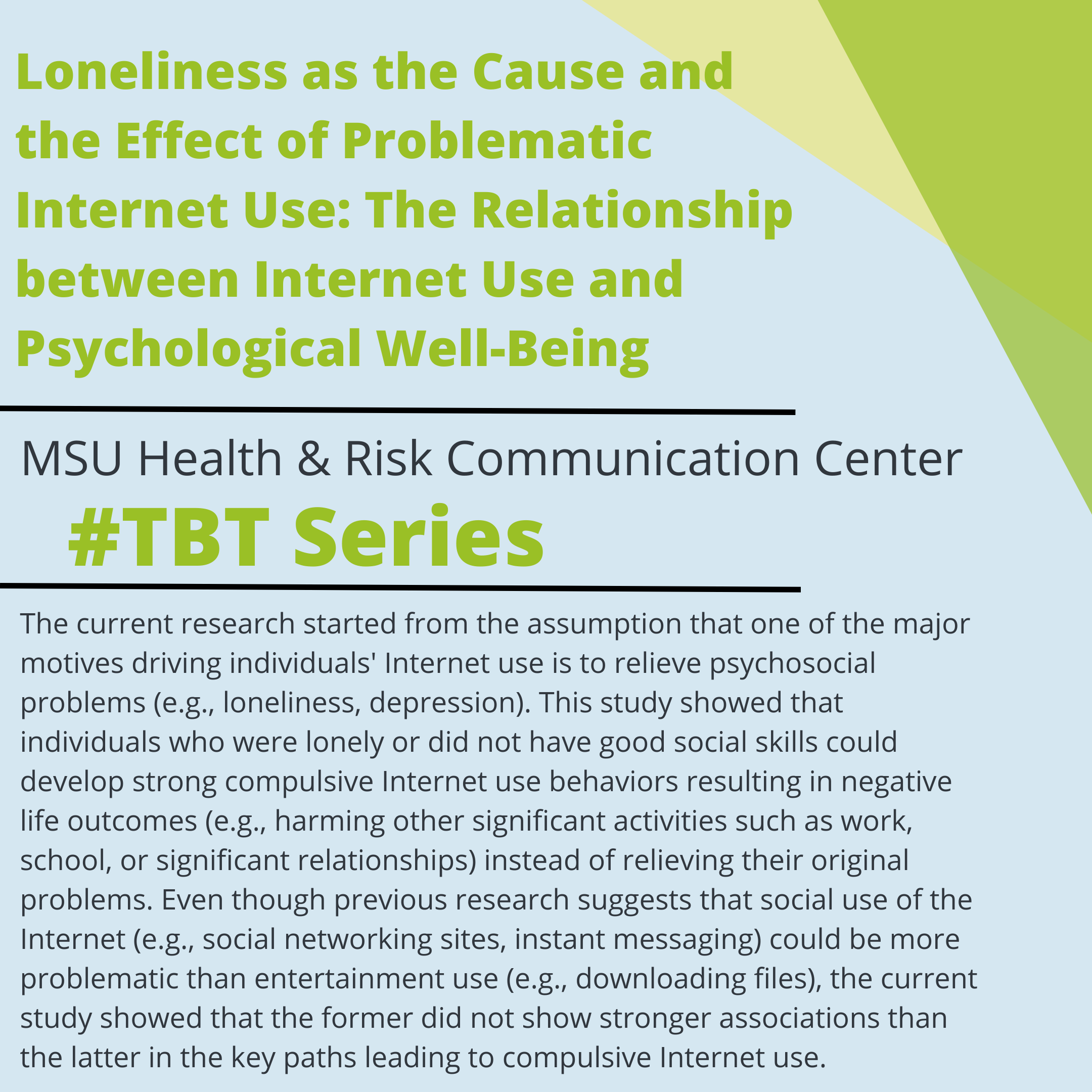
Loneliness as the Cause and the Effect of Problematic Internet Use: The Relationship between Internet Use and Psychological Well-Being
May 25, 2023 - Authors: Jung-Hyun Kim (Sogang University), Robert Larose (Michigan State University), and Wei Peng (Michigan State University)
The current research started from the assumption that one of the major motives driving individuals' Internet use is to relieve psychosocial problems (e.g., loneliness, depression). This study showed that individuals who were lonely or did not have good social skills could develop strong compulsive Internet use behaviors resulting in negative life outcomes (e.g., harming other significant activities such as work, school, or significant relationships) instead of relieving their original problems. Such augmented negative outcomes were expected to isolate individuals from healthy social activities and lead them into more loneliness. Even though previous research suggests that social use of the Internet (e.g., social networking sites, instant messaging) could be more problematic than entertainment use (e.g., downloading files), the current study showed that the former did not show stronger associations than the latter in the key paths leading to compulsive Internet use.
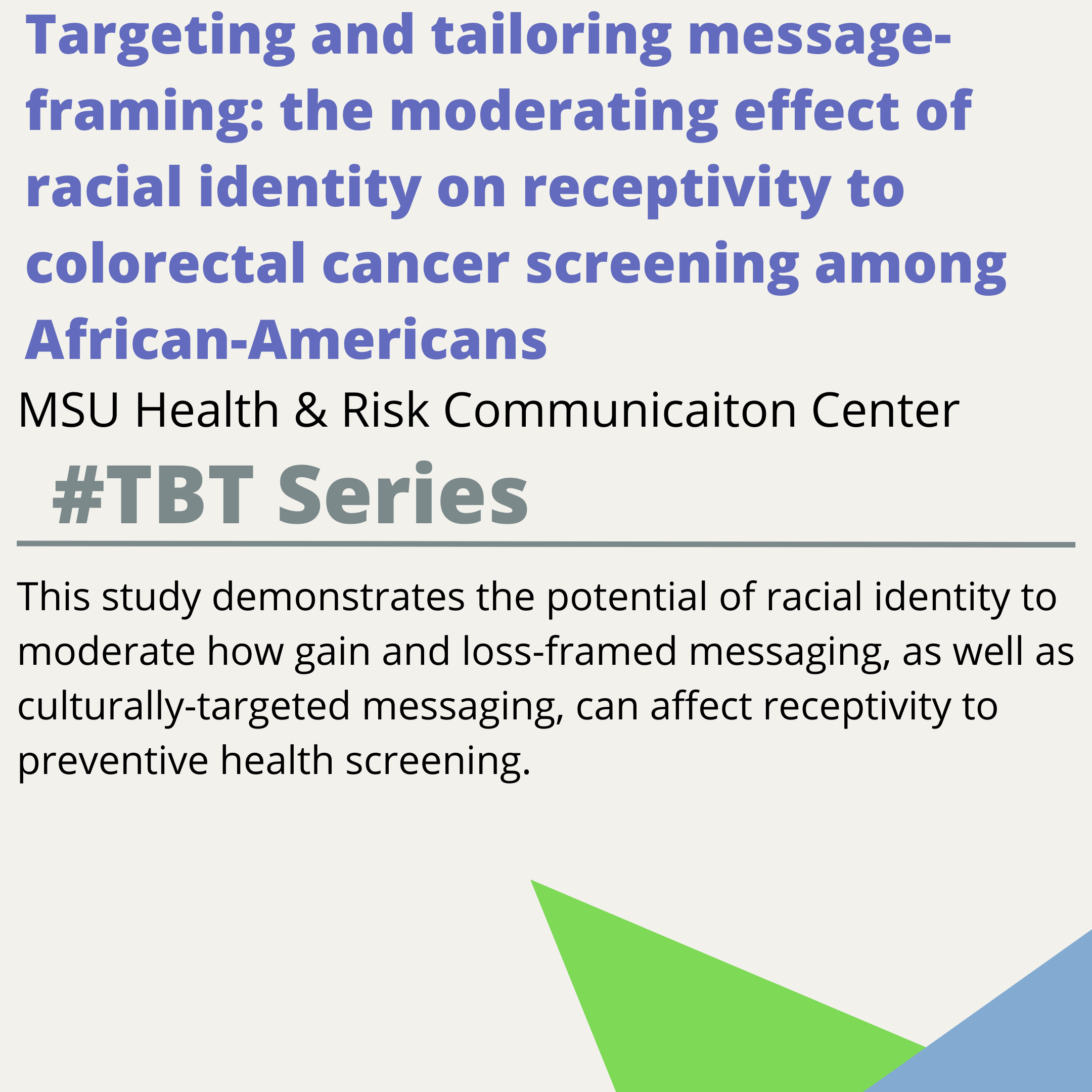
Targeting and tailoring message-framing: the moderating effect of racial identity on receptivity to colorectal cancer screening among African-Americans
July 6, 2022 - Todd Lucas, Marking Manning, Lenwood W. Hayman Jr, and James Blessman
This study demonstrates the potential of racial identity to moderate how gain and loss-framed messaging, as well as culturally-targeted messaging, can affect receptivity to preventive health screening.
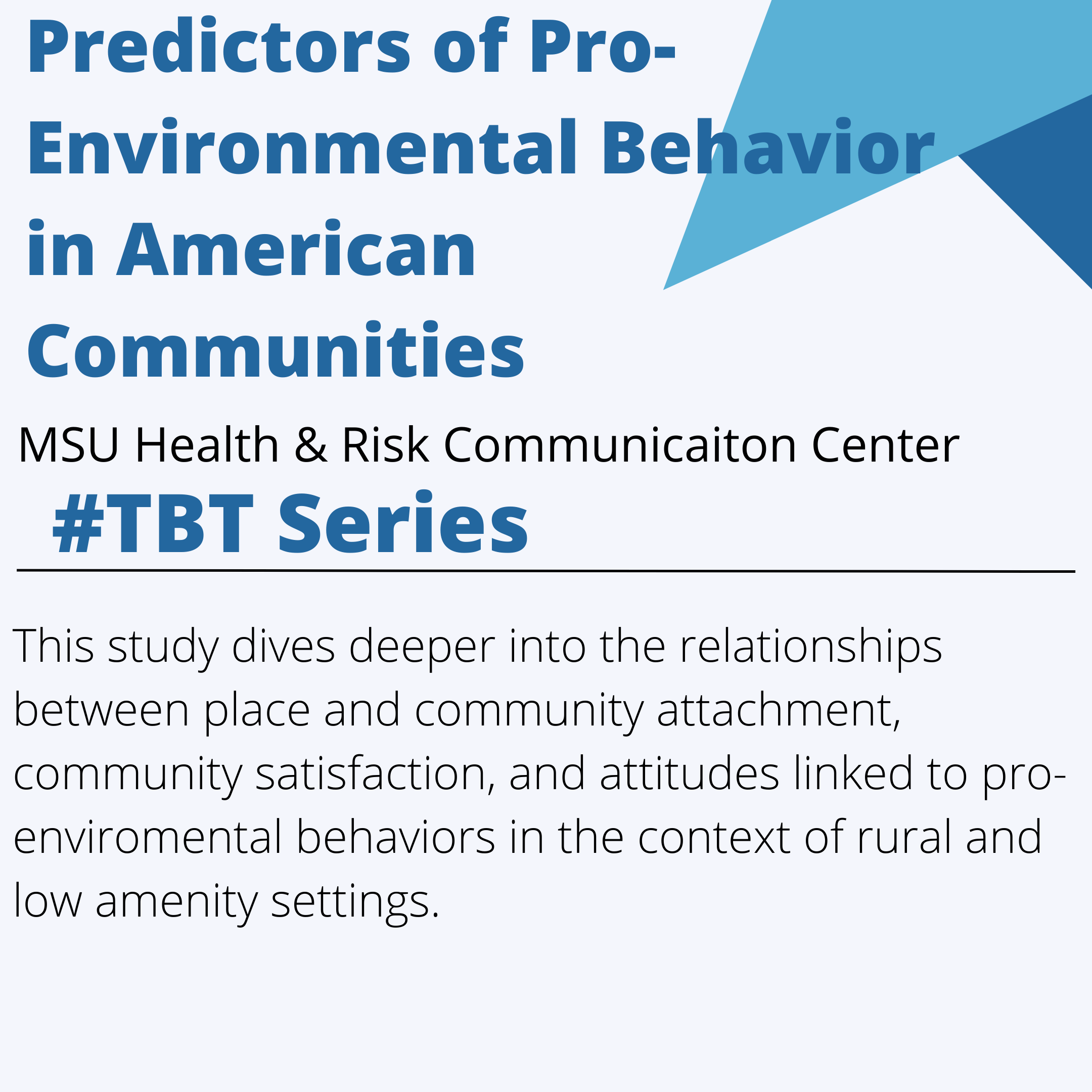
Predictors of Pro-Environmental Behaviors in Rural American Communities
April 20, 2022 - Bruno Takahashi and Theresa Selfa
This study dives deeper into the relationships between place and community attachment, community satisfaction, and attitudes linked to pro-environmental behaviors in the context of rural and low amenity settings.
How scientists view the public, the media, and the political process
March 22, 2022 - John Besley and Matthew Nisbet
A review of past studies on how scientists view the public, the goals of communication, the performance and impacts of the media, and the role of public in policy decision-making. Analyses show scientists believe the public is uniformed about science & prone to errors in judgement along with policy preferences. Few scientists view their role as an enabler of direct public participation, instead view policy makers as the most important group to engage with.
Voice restoration following total laryngectomy by tracheoesophageal prosthesis: effect on patients' quality of life and voice handicap in Jordan
February 16, 2022 - Abdelrahim Attieh, Jeff Searl, Nada Shahaltough, Mahmoud Wreikat, and Donna Lundy
After total laryngectomy, individuals in Europe & North America rated their quality of life as being lower than those who had not undergone the procedure. The purpose of this study was to evaluate the quality of life, as well as, degree of voice handicap reported by laryngectomized speakers from Jordan before and after the establishment of TE speech.
Feasibility of Group Voice Therapy for Individuals with Parkinson's Disease
February 10, 2022 - Jeff Searl, Kristel Wilson, Karen Haring, Angela Dietsch, Kelly Lyons, Rajesh Pahwa
The purpose of this study was to demonstrate the feasibility of executing treatment tasks that focused on increasing loudness in group settings for individuals with Parkinson's disease (PD). The secondary purpose was to report preliminary pre-to-post treatment outcomes for individuals with PD immediately after completion of group therapy.
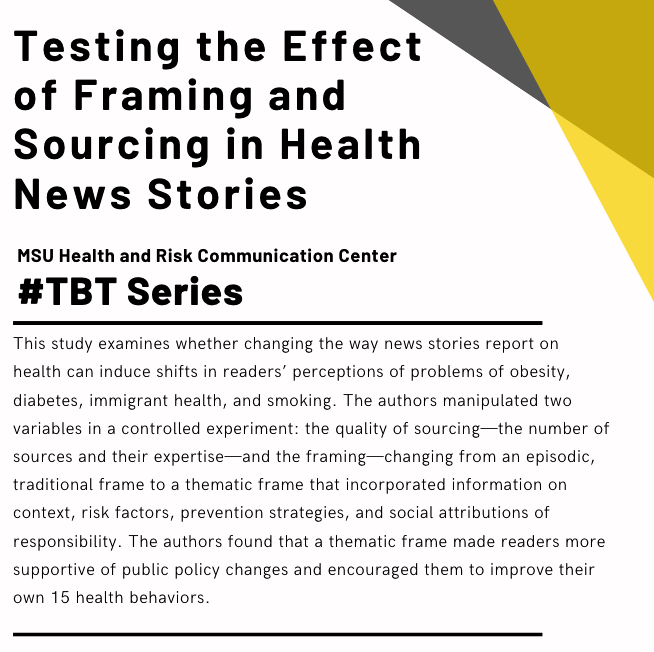
Testing the Effect and Sourcing in Health News Stories
October 27, 2021 - Esthor Thorson, Lee Wilkins, Renita Coleman
This study examines whether changing the way news stories report on health can induce shifts in readers’ perceptions of problems of obesity, diabetes, immigrant health, and smoking.
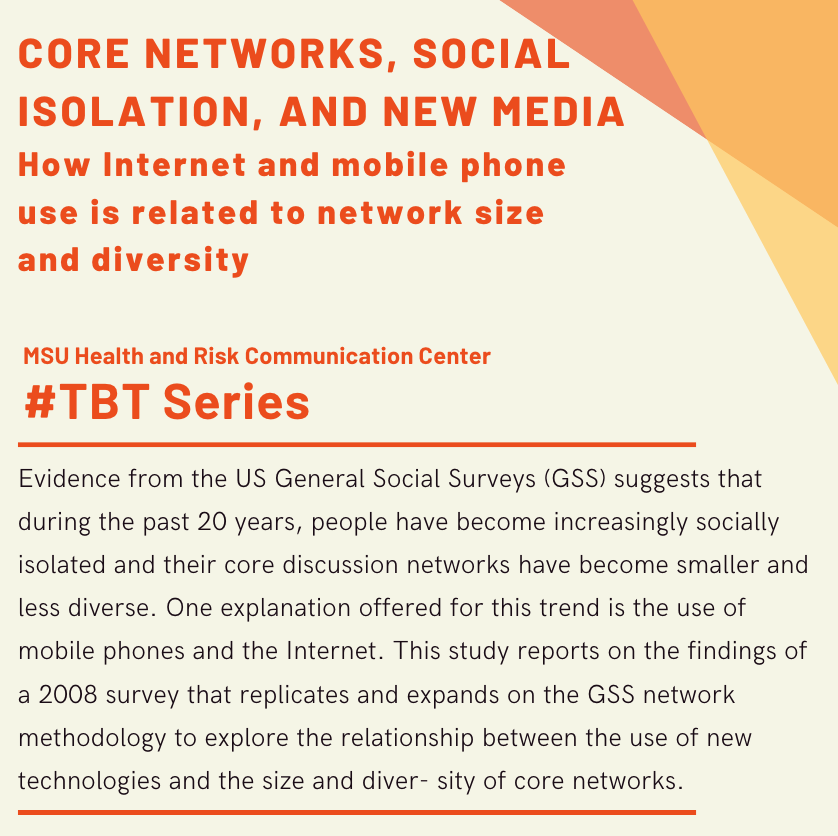
Core Networks, Social Isolation, and New Media - How Internet and Mobile Phone Use is Related to Network Size and Diversity
October 20, 2021 - Keith N. Hampton, Lauren F. Sessions, Eun Ja Her
Evidence from the US General Social Surveys (GSS) suggests that during the past 20 years, people have become increasingly socially isolated and their core discussion networks have become smaller and less diverse. One explanation offered for this trend is the use of mobile phones and the Internet. This study reports on the findings of a 2008 survey that replicates and expands on the GSS network methodology to explore the relationship between the use of new technologies and the size and diversity of core networks.
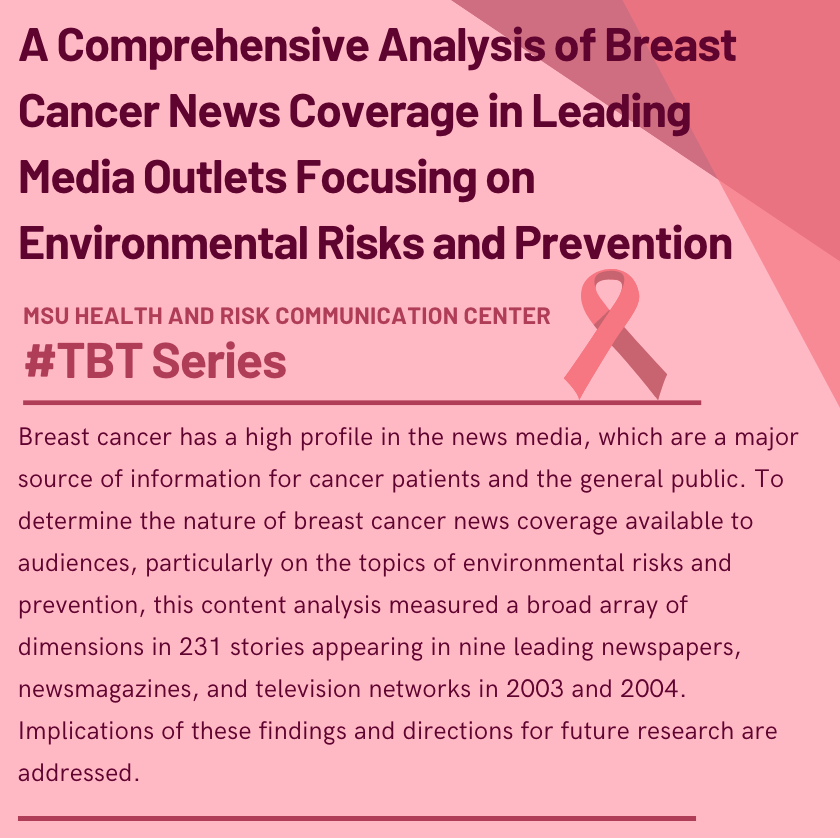
A Comprehensive Analysis of Breast Cancer News Coverage in Leading Media Outlets Focusing on Environmental Risks and Prevention
October 13, 2021 - Charles K. Atkin, Sandi W. Smith, Courtnay McFeters, Vanessa Ferguson
Breast cancer has a high profile in the news media, which are a major source of information for cancer patients and the general public. To determine the nature of breast cancer news coverage available to audiences, particularly on the topics of environmental risks and prevention, this content analysis measured a broad array of dimensions in 231 stories appearing in nine leading newspapers, news magazines, and television networks in 2003 and 2004. Implications of these findings and directions for future research were addressed.
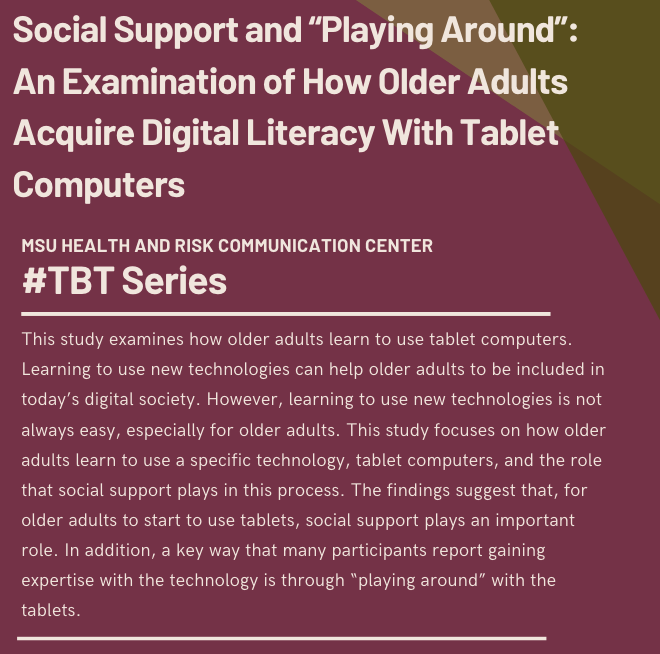
Social Support and "Playing Around": An Examination of How Older Adults Acquire Digital Literacy With Tablet Computers
October 6, 2021 - Ruth Shillair, Hsin-yi Sandy Tsai, Sheila R. Cotten
This study examines how older adults learn to use tablet computers. Learning to use new technologies can help older adults to be included in today’s digital society. However, learning to use new technologies is not always easy, especially for older adults. This study focuses on how older adults learn to use a specific technology, tablet computers, and the role that social support plays in this process. Data for this project are from 21 in-depth interviews with individuals who own tablet computers. We examine how older adults engage with tablet devices and increase their digital literacy. The findings suggest that, for older adults to start to use tablets, social support plays an important role. In addition, a key way that many participants report gaining expertise with the technology is through “playing around” with the tablets. Suggestions for how to help older adults learn to use new technologies are detailed.
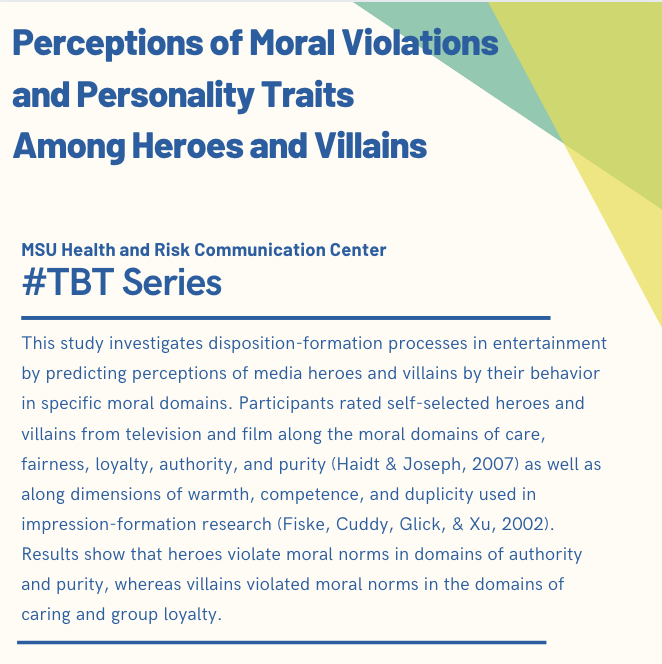
Perceptions of Moral Violations and Personality Traits Among Heroes and Villians
September 29, 2021 - Allison Eden, Mary Beth Oliver, Ron Tamborini, Anthony Limperos, Julie Woolley
This study investigates disposition-formation processes in entertainment by predicting perceptions of media heroes and villains by their behavior in specific moral domains. Participants rated self-selected heroes and villains from television and film along the moral domains of care, fairness, loyalty, authority, and purity (Haidt & Joseph, 2007) as well as along dimensions of warmth, competence, and duplicity used in impression-formation research (Fiske, Cuddy, Glick, & Xu, 2002). Results show that heroes violate moral norms in domains of authority and purity, whereas villains violated moral norms in the domains of caring and group loyalty. Furthermore, these moral violations are associated with personality dimensions of warmth and competence differently for each character type, such that impressions of heroes are driven by their work in the care domain (i.e., saving or protecting people), whereas for villains, violation of purity norms is most strongly associated with subsequent impression formation processes.
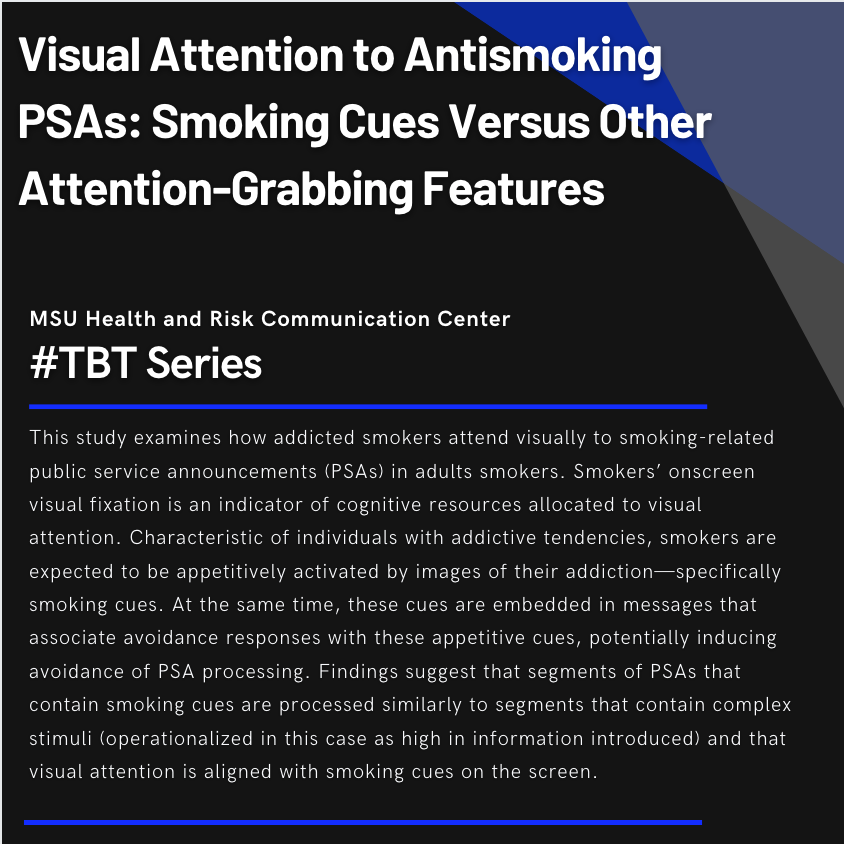
Visual Attention to Antismoking PSAs: Smoking Cues Versus Other Attention-Grabbing Features
September 15, 2021 - Ashley N. Sanders-Jackson, Joseph N. Cappella, Deborah L. Linebarger, Jessica Taylor Piotrowski, Moira O'Keeffe, Andrew A. Strasser
This study examines how addicted smokers attend visually to smoking-related public service announcements (PSAs) in adults smokers. Smokers’ onscreen visual fixation is an indicator of cognitive resources allocated to visual attention. Characteristic of individuals with addictive tendencies, smokers are expected to be appetitively activated by images of their addiction— specifically smoking cues. At the same time, these cues are embedded in messages that associate avoidance responses with these appetitive cues, potentially inducing avoidance of PSA processing. Findings suggest that segments of PSAs that contain smoking cues are processed similarly to segments that contain complex stimuli (operationalized in this case as high in information introduced) and that visual attention is aligned with smoking cues on the screen.
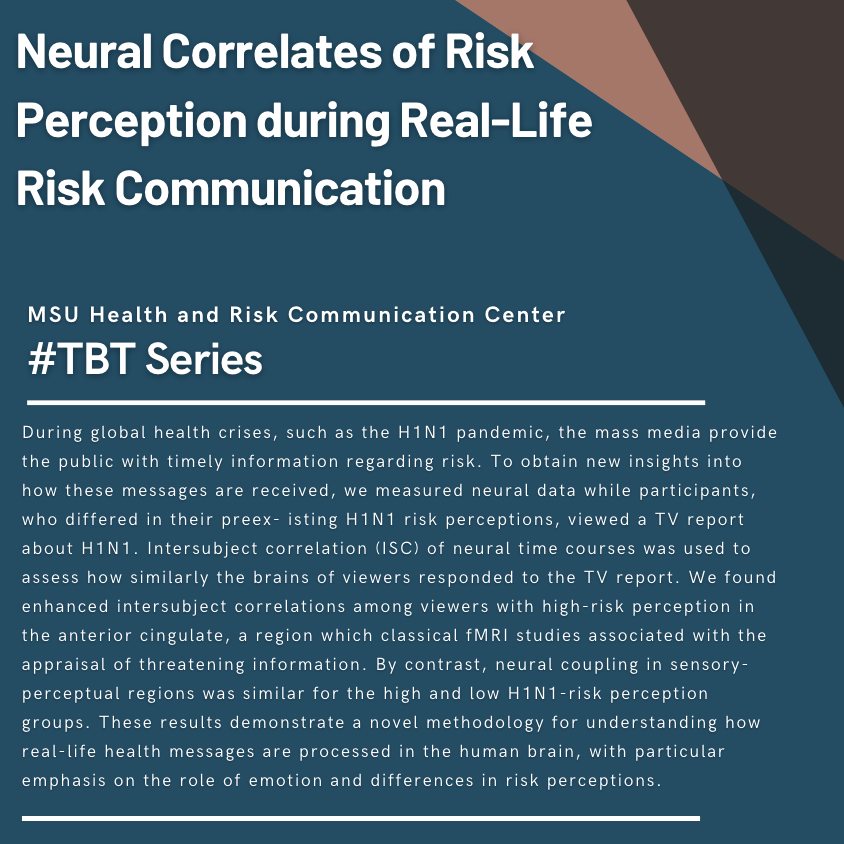
Neural Correlates of Risk Perception During Real-Life Risk Communication
September 8, 2021 - Ralf Schmälzle, Frank Hacker, Britta Renner, Christopher J. Honey, Harald R. Schupp
During global health crises, such as the H1N1 pandemic, the mass media provide the public with timely information regarding risk. To obtain new insights into how these messages are received, this study measured neural data while participants, who differed in their pre-existing H1N1 risk perceptions, viewed a TV report about H1N1. Intersubject correlation (ISC) of neural time courses was used to assess how similarly the brains of viewers responded to the TV report.
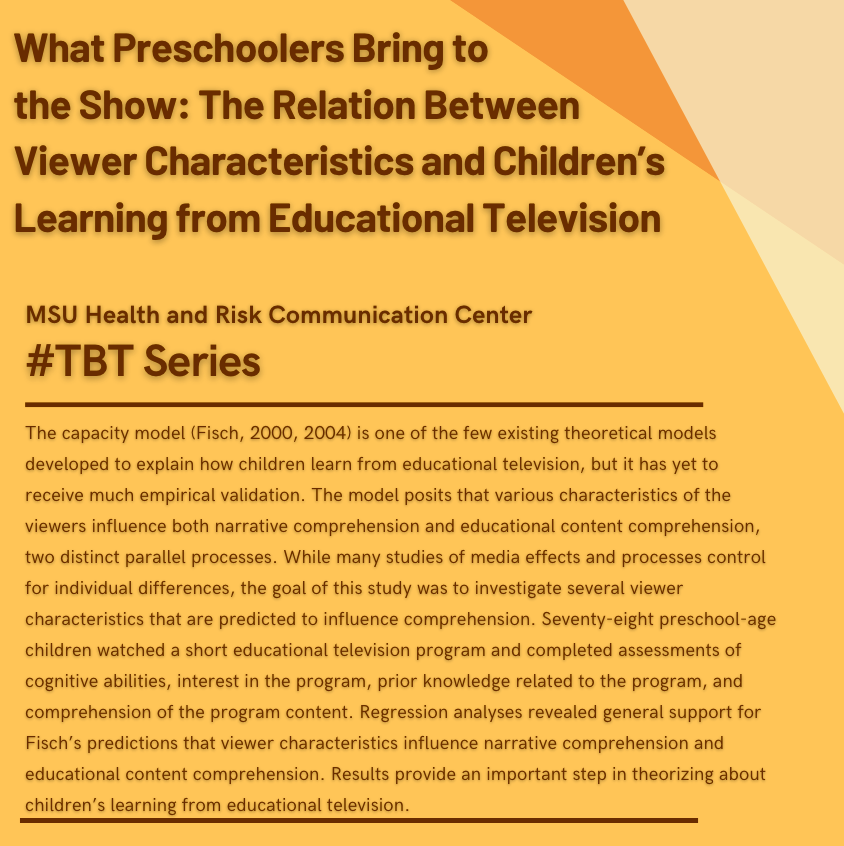
What Preschoolers Bring to the Show: The Relation Between Viewer Characteristics and Children's Learning From Educational Television
September 1, 2021 - Fashina Alade, Amy I. Nathanson
While many studies of media effects and processes control for individual differences, the goal of this study was to investigate several viewer characteristics that are predicted to influence comprehension. Results from the study provide an important step in theorizing about children’s learning from educational television.
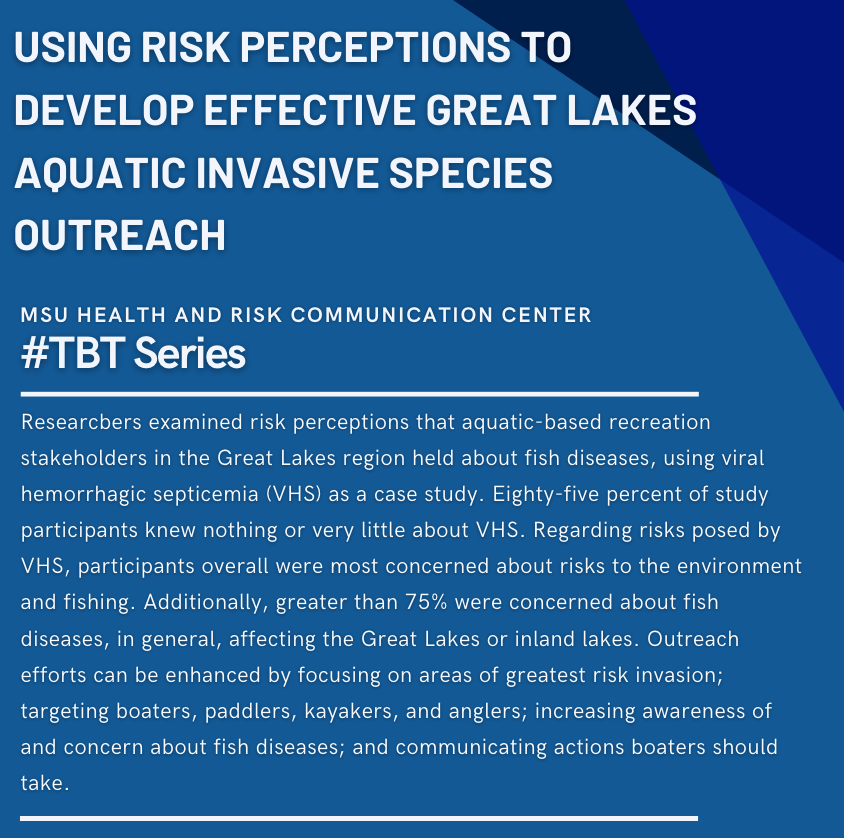
Using Risk Perceptions to Develop Effective Greate Lakes Aquatic Invasic Species Outreach
August 25, 2021 - Bruno Takahashi, Erin L. Pavloski, Heather A. Triezenberg, William W. Taylor
In this study researchers examined risk perceptions that aquatic-based recreation stakeholders in the Great Lakes region held about fish diseases, using viral hemorrhagic septicemia (VHS) as a case study.
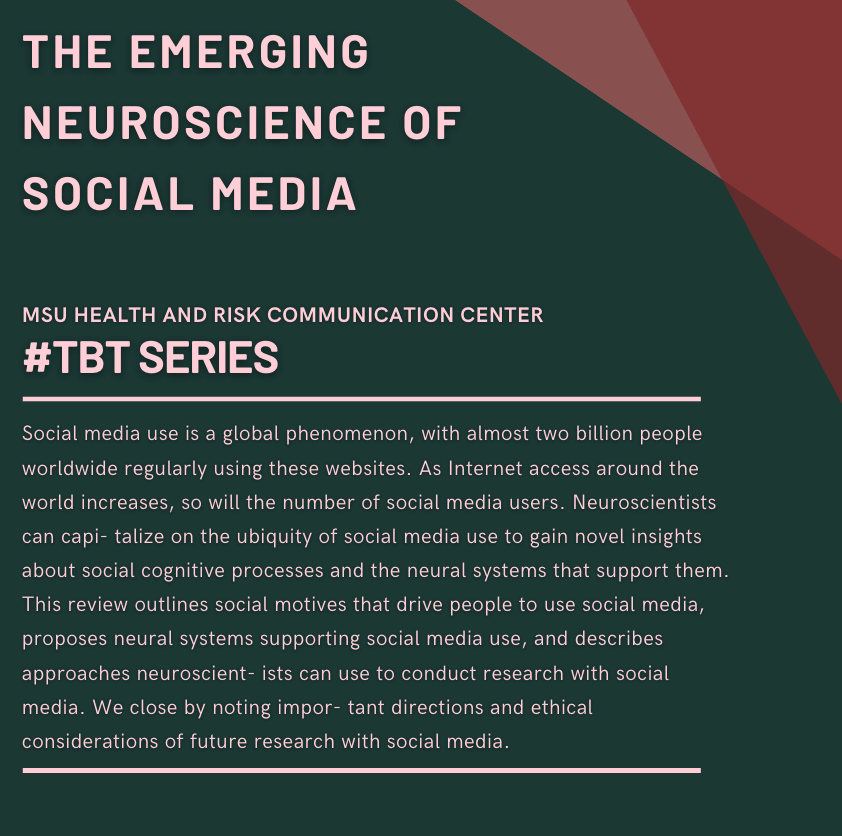
The Emerging Neuroscience of Social Media
August 18, 2021 - Dar Meshi, Diana I. Tamir, Hauke R. Heekeren
Social media use is a global phenomenon, with almost two billion people worldwide regularly using these websites. As Internet access around the world increases, so will the number of social media users. Neuroscientists can capitalize on the ubiquity of social media use to gain novel insights about social cognitive processes and the neural systems that support them. This review outlines social motives that drive people to use social media, proposes neural systems supporting social media use, and describes approaches neuroscientists can use to conduct research with social media.
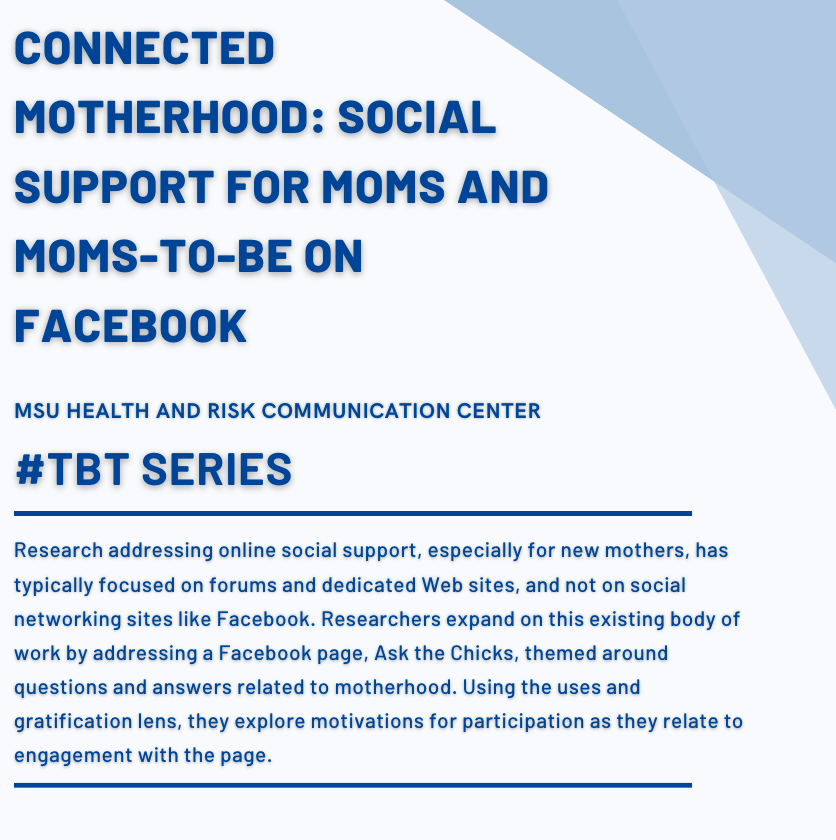
Connected Motherhood: Social Support for Moms and Moms-To-Be On Facebook
August 11, 2021 - Bree Holtz, Andrew Smock, David Reyes-Gastelum
Research addressing online social support, especially for new mothers, has typically focused on forums and dedicated Web sites, and not on social networking sites like Facebook. In this article researchers expand on this existing body of work by addressing a Facebook page, Ask the Chicks, themed around questions and answers related to motherhood. Using the uses and gratification lens, we explore motivations for participation as they relate to engagement with the page.
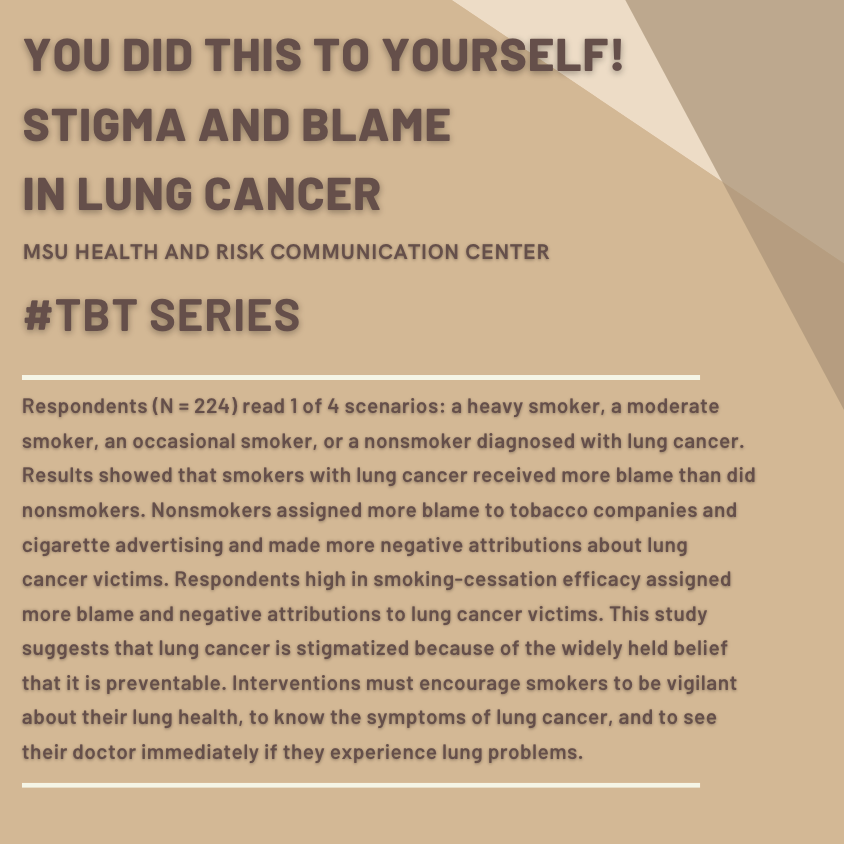
You Did This to Yourself! Stigma and Blame in Lung Cancer
August 4, 2021 - Mary Bresnahan, Kami Silk, Jie Zhuang
When people learn that someone has lung cancer, often the first assumption is that this person must have been a heavy smoker (Eldridge, 2011). Similarly, when people learn that someone has liver failure, they assume the person is a heavy drinker (Liver Foundation, 2011); or when someone has AIDS, they assume this person must have been sexually promiscuous or an intravenous drug user (Cichocki, 2011). What lung cancer, liver failure, and AIDS have in common is that assumptions about what caused these conditions are inaccurate and stigmatized.
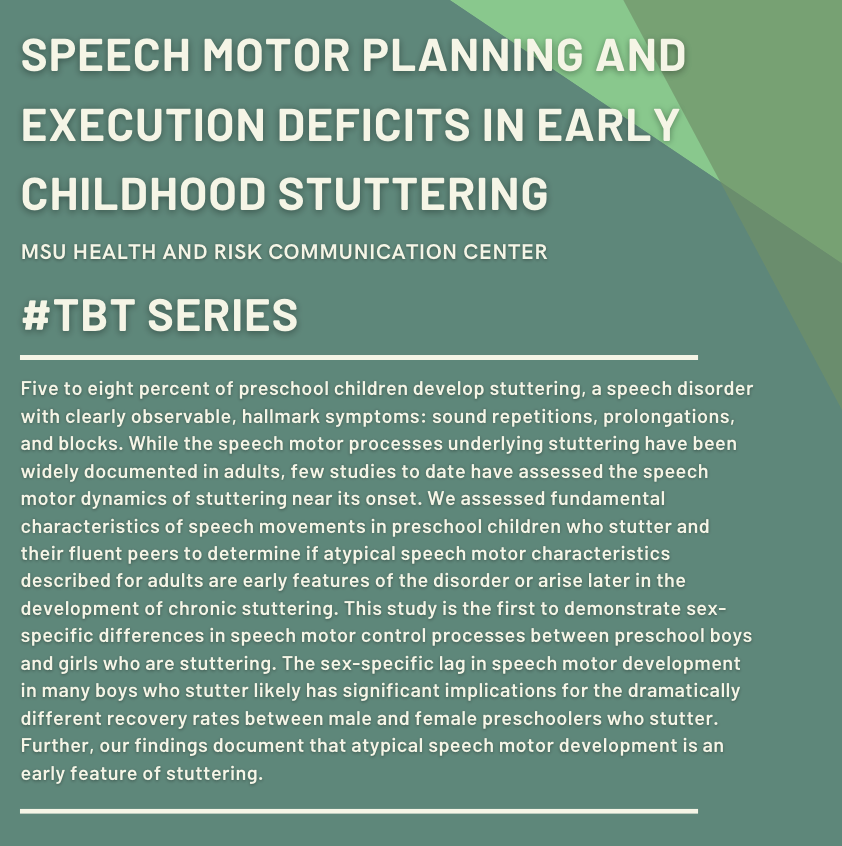
Speech Motor Planning and Execution Deficits in Early Childhood Stuttering
July 21, 2021 - Bridget Walsh, Kathleen Marie Mettel, Anne Smith
This study is the first to demonstrate sex-specific differences in speech motor control processes between preschool boys and girls who are stuttering. The sex-specific lag in speech motor development in many boys who stutter likely has significant implications for the dramatically different recovery rates between male and female preschoolers who stutter. Further, the findings document that atypical speech motor development is an early feature of stuttering.
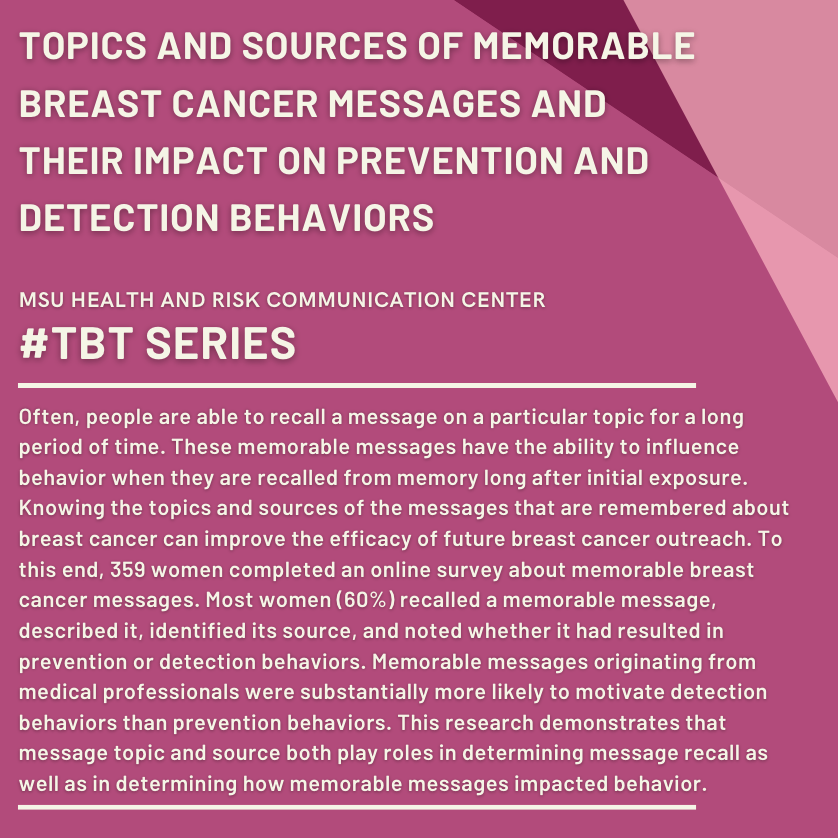
Topics and Sources of Memorable Breast Cancer Messages and Their Impact on Prevention and Detection Behaviors
July 7, 2021 - Dr. Sandi W. Smith, Samantha Nazione, Carolyn LaPlante, Michael R. Kotowski, Charles Atkin, Christine M. Skubisz, Cynthia Stohl
Often, people are able to recall a message on a particular topic for a long period of time. These memorable messages have the ability to influence behavior when they are recalled from memory long after initial exposure. Knowing the topics and sources of the messages that are remembered about breast cancer can improve the efficacy of future breast cancer outreach.
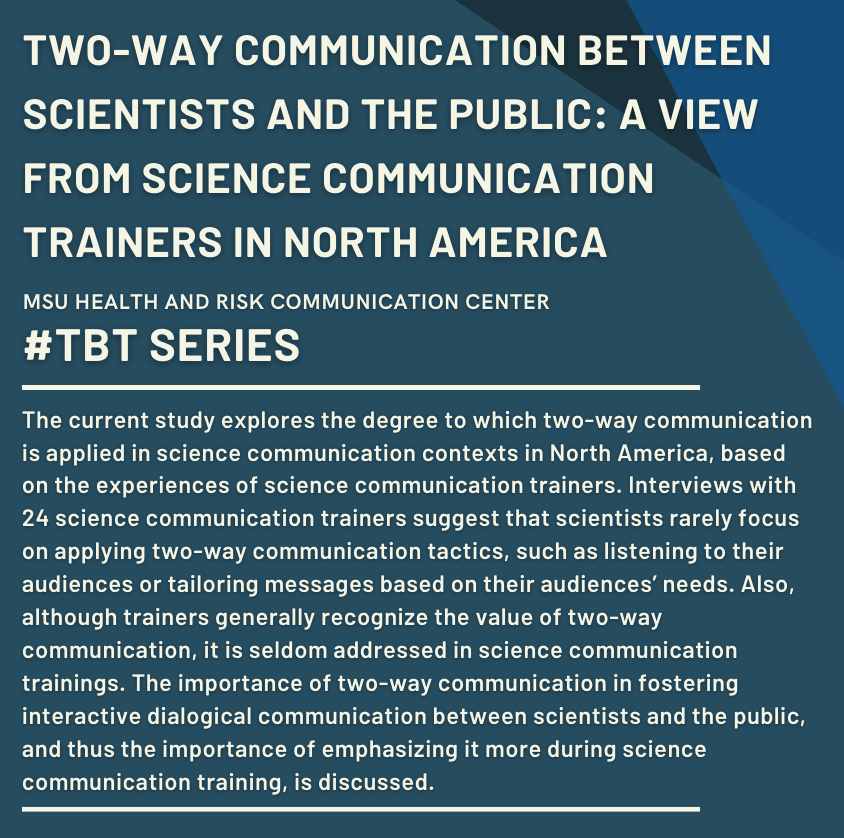
Two-Way Communication Between Scientists and the Public: A View From Science Communication Trainers in North America
June 16, 2021 - John C. Besley, Shupei Yuan, Tsuyoshi Oshita, Niveen AbiGhannam, Anthony Dudo, Hyeseung E. Koh
This study explores the degree to which two-way communication is applied in science communication contexts in North America, based on the experiences of science communication trainers. Interviews with 24 science communication trainers suggest that scientists rarely focus on applying two-way communication tactics, such as listening to their audiences or tailoring messages based on their audiences’ needs. Also, although trainers generally recognize the value of two-way communication, it is seldom addressed in science communication trainings.
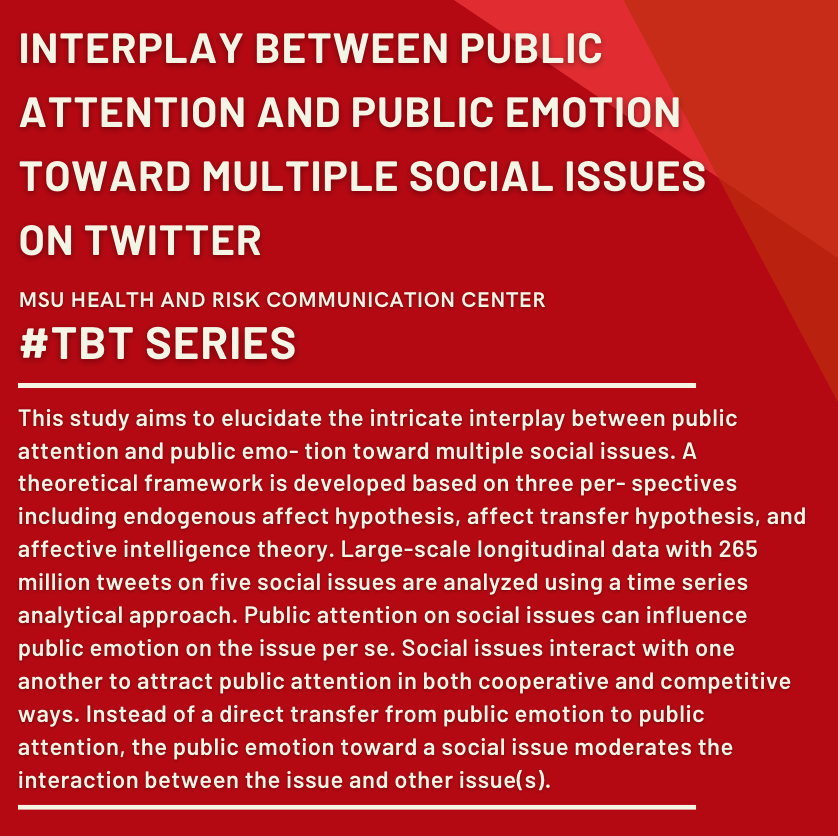
Interplay Between Public Attention and Public Emotion Toward Multiple Social Issues on Twitter
June 9, 2021 - Tai-Quan Peng, Guodao Sun, Yingcai Wu
The dynamic recruitment and distraction of public attention toward social issues has been an intriguing yet unanswered question in political communication research. Many scholars have developed conceptual and mathematical models to explicate the mechanisms that underlie the dynamics of public attention, such as issue-attention cycle, threshold of public attention, and zero-sum game theory of public attention. However, few studies have investigated the intricate link between what issues the general public thinks about (i.e., public attention) and how they feel about these issues (i.e., public emotion).
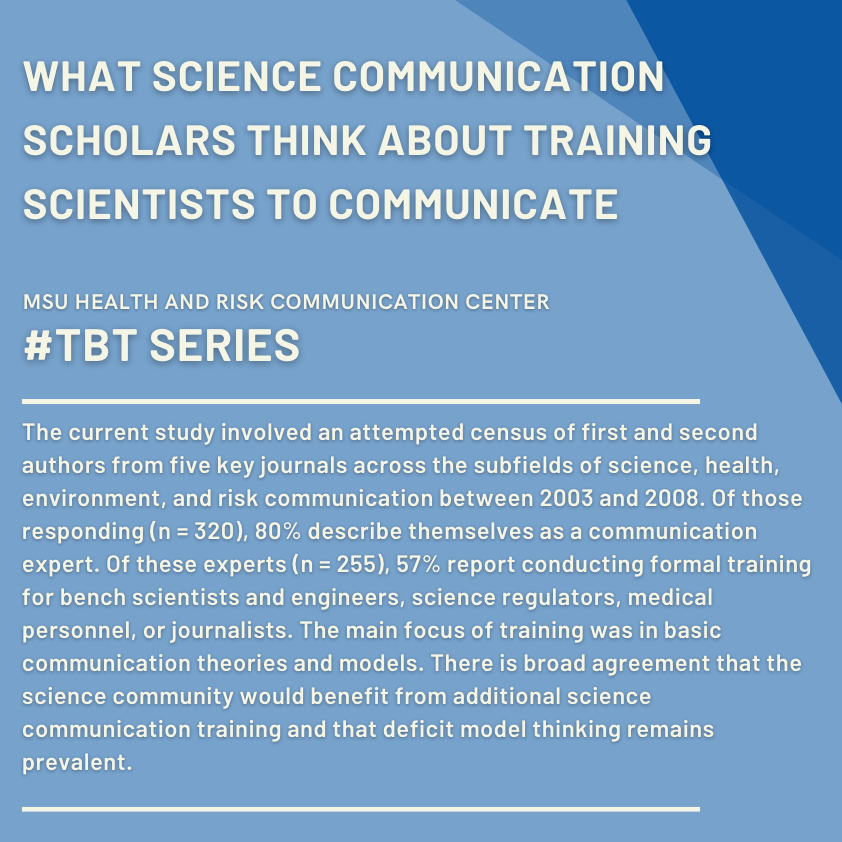
What Science Communication Scholars Think About Training Scientists to Communicate
May 26, 2021 - John C. Besley and Andrea H. Tanner
The current study involved an attempted census of first and second authors from five key journals across the subfields of science, health, environment, and risk communication between 2003 and 2008. Of those responding (n = 320), 80% describe themselves as a communication expert. Of these experts (n = 255), 57% report conducting formal training for bench scientists and engineers, science regulators, medical personnel, or journalists. The main focus of training was in basic communication theories and models. There is broad agreement that the science community would benefit from additional science communication training and that deficit model thinking remains prevalent.
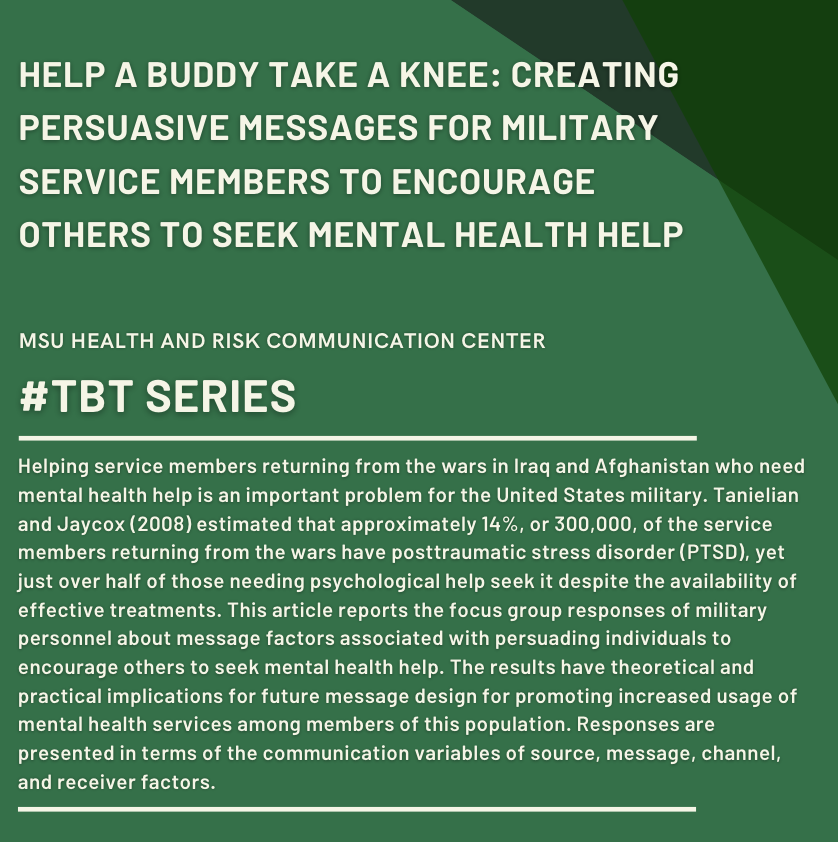
Help a Buddy Take a Knee: Creating Persuasive Messages for Military Service Members to Encourage Others to Seek Mental Health Help
May 12, 2021 - Dr. Sandi W. Smith
This article reports the focus group responses of military personnel about message factors associated with persuading individuals to encourage others to seek mental health help. The results have theoretical and practical implications for future message design for promoting increased usage of mental health services among members of this population. Responses are presented in terms of the communication variables of source, message, channel, and receiver factors.
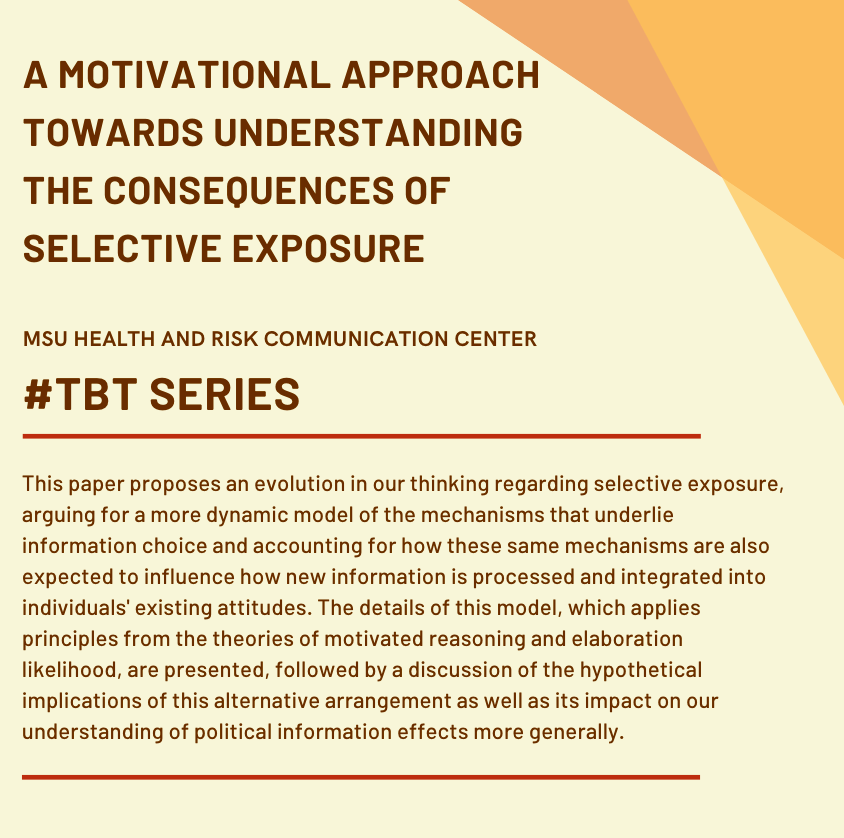
A Motivation-Based Approach towards Understanding the Causes and Consequences of Selective Exposure
May 5, 2021 - Dustin Carnahan
Scholarly interest in the phenomenon of selective exposure to political information has peaked over the past decade with the dawn of the information age. While much of this research has focused on the extent to which we are witnessing a shift towards selectivity amongst the electorate, the literature to this point has been devoid of additional theoretical development that aids in our understanding of what motivates selective information-seeking practices as well as what implications such practices have for political attitudes and tolerance. This paper proposes an evolution in our thinking regarding selective exposure, arguing for a more dynamic model of the mechanisms that underlie information choice and accounting for how these same mechanisms are also expected to influence how new information is processed and integrated into individuals' existing attitudes.
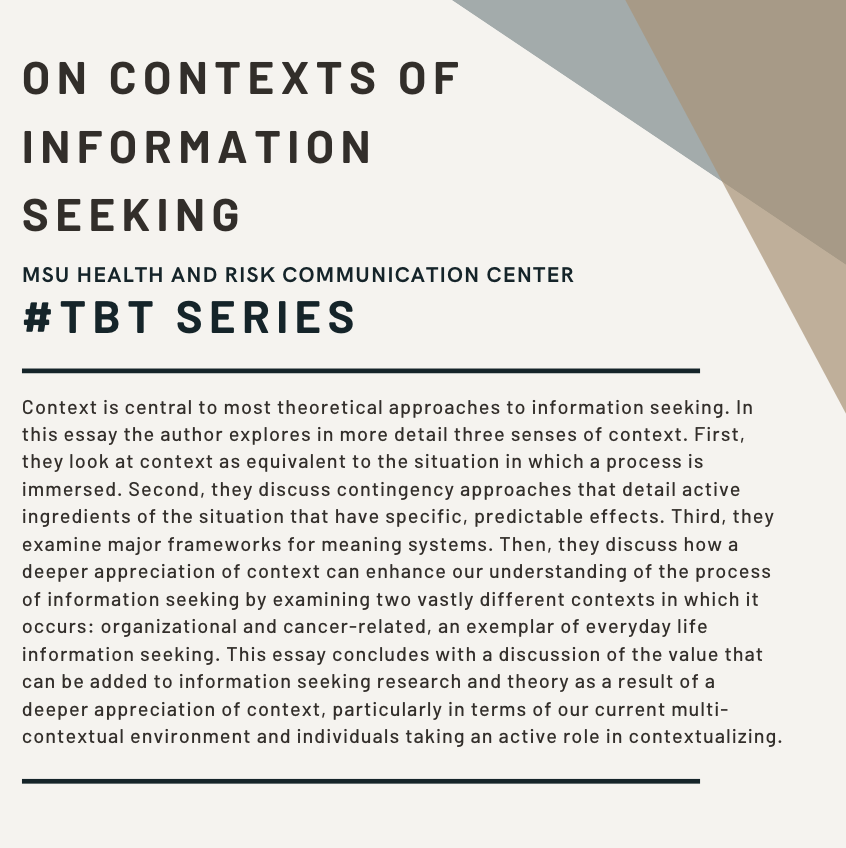
On Contexts of Information Seeking
April 29, 2021 - J. David Johnson
This article discusses why context is central to most theoretical approaches to information seeking and explores in more detail three senses of context. The article concludes with a discussion of the value that can be added to information seeking research and theory as a result of a deeper appreciation of context, particularly in terms of our current multi-contextual environment and individuals taking an active role in contextualizing.
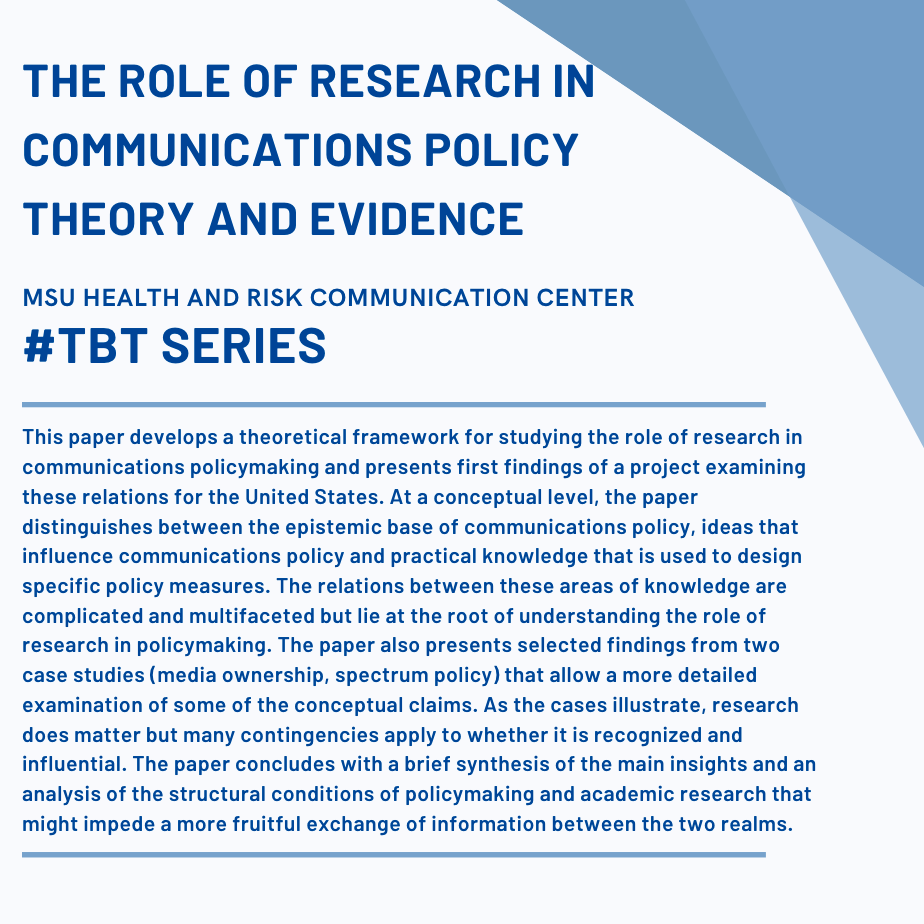
The Role of Research in Communications Policy Theory and Evidence
April 14, 2021 - Bella Mody, Johannes M. Bauer, Sungjoong Kim, Steven S. Wildman
This paper develops a theoretical framework for studying the role of research in communications policymaking and presents first findings of a project examining these relations for the United States. At a conceptual level, the paper distinguishes between the epistemic base of communications policy, ideas that influence communications policy and practical knowledge that is used to design specific policy measures. The relations between these areas of knowledge are complicated and multifaceted but lie at the root of understanding the role of research in policymaking. The paper also presents selected findings from two case studies (media ownership, spectrum policy) that allow a more detailed examination of some of the conceptual claims. As the cases illustrate, research does matter but many contingencies apply to whether it is recognized and influential. The paper concludes with a brief synthesis of the main insights and an analysis of the structural conditions of policymaking and academic research that might impede a more fruitful exchange of information between the two realms.
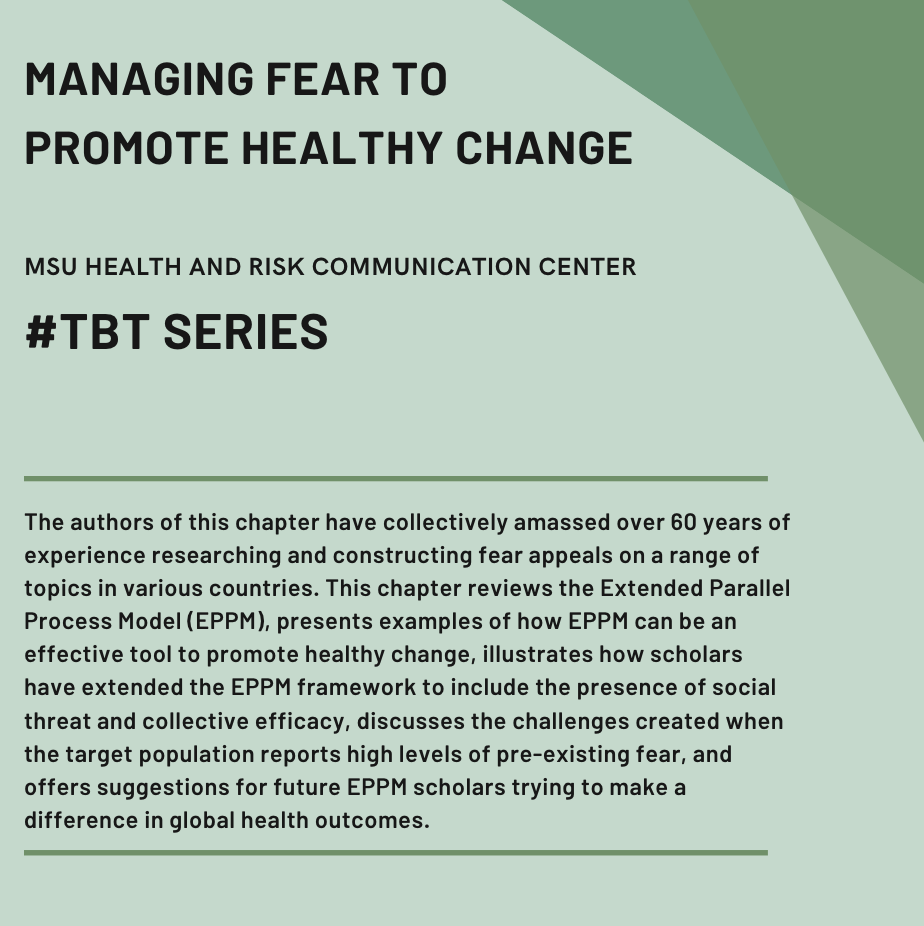
Managing Fear to Promote Healthy Change
April 7, 2021 - Kim Witte, Merissa Ferrara, Anthony J. Roberto
This week’s #TBT comes from Dr. Kim Witte, a Communications Scholar and former MSU faculty member. This chapter reviews the Extended Parallel Process Model (EPPM), presents examples of how EPPM can be an effective tool to promote healthy change, illustrates how scholars have extended the EPPM framework to include the presence of social threat and collective efficacy, discusses the challenges created when the target population reports high levels of pre-existing fear, and offers suggestions for future EPPM scholars trying to make a difference in global health outcomes.
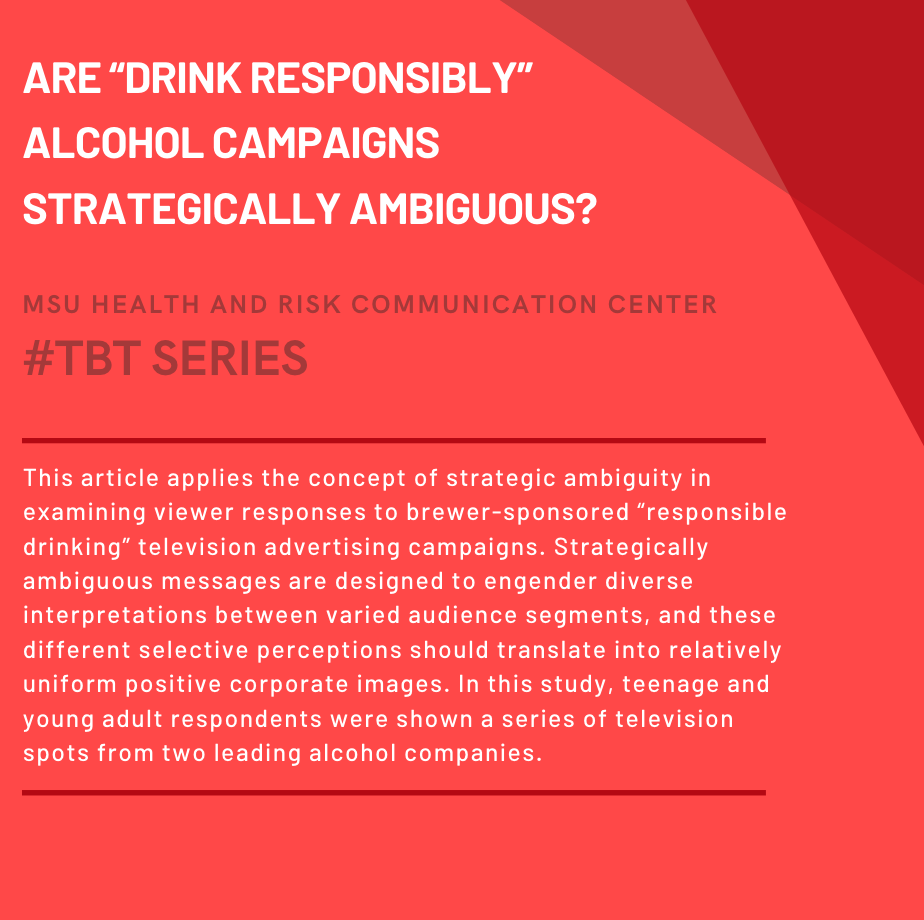
Are "Drink Responsibly" Alcohol Campaigns Strategically Ambiguous?
March 31, 2021 - Charles K. Atkin, Sandi W. Smith, JoAnn Roznowski
This article applies the concept of strategic ambiguity in examining viewer responses to brewer-sponsored “responsible drinking” television advertising campaigns. Strategically ambiguous messages are designed to engender diverse interpretations between varied audience segments, and these different selective perceptions should translate into relatively uniform positive corporate images. In this study, teenage and young adult respondents were shown a series of television spots from two leading alcohol companies. As predicted, there was a high degree of diversity in meanings of message content and campaign purpose derived by viewers, particularly among less sophisticated teenagers. Moreover, evaluative ratings of messages and sponsors were generally favorable and more uniform than interpretive responses. The research demonstrates how seemingly prohealth messages can serve to subtly advance both industry sales and public relations interests.
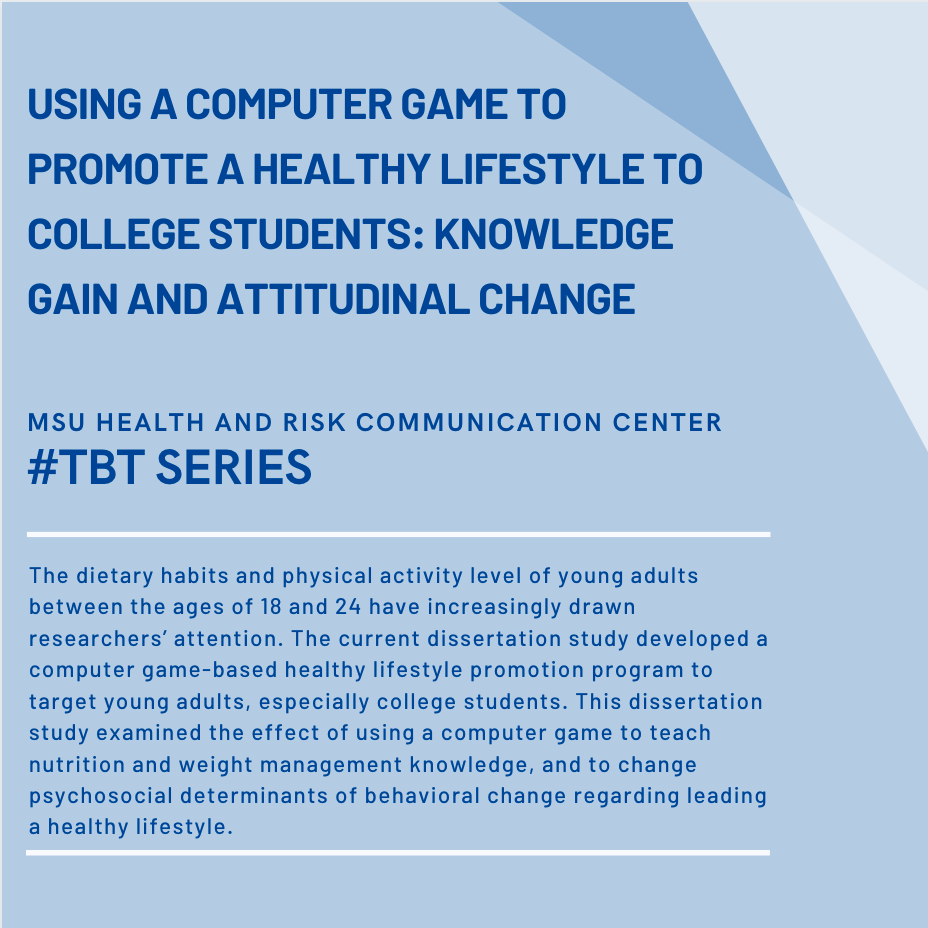
Using a Computer Game to Promote a Healthy Lifestyle to College Students: Knowledge Gain and Attitudinal Change
March 24, 2021 - Wei Peng
The dietary habits and physical activity level of young adults between the ages of 18 and 24 have increasingly drawn researchers’ attention. The current dissertation study developed a computer game-based healthy lifestyle promotion program to target young adults, especially college students. In collaboration with a dietitian and two programmers, this RightWay Cafe game was developed based on Social Cognitive Theory, Health Belief Model, and Theory of Reasoned Action.
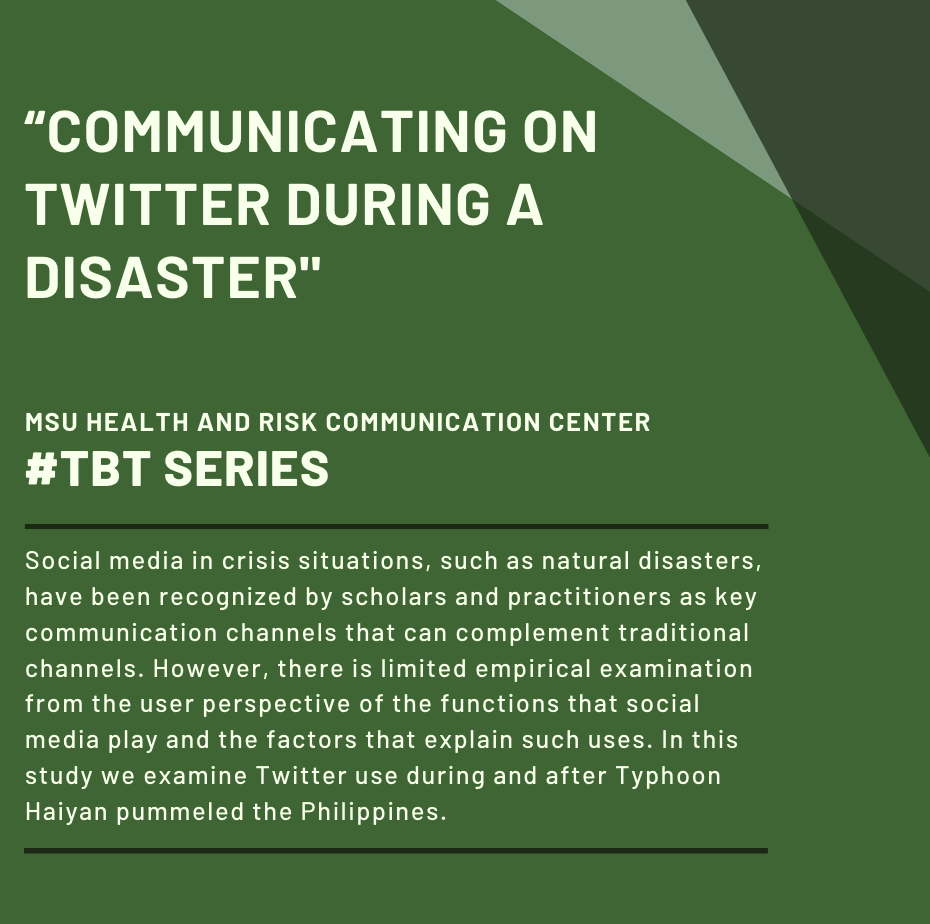
Communicating on Twitter During a Disaster
March 11, 2021 - Bruno Takahashi, Edson C. Tandoc Jr., Christine Carmichael
Social media in crisis situations, such as natural disasters, have been recognized by scholars and practitioners as key communication channels that can complement traditional channels. However, there is limited empirical examination from the user perspective of the functions that social media play and the factors that explain such uses. In this study we examine Twitter use during and after Typhoon Haiyan pummeled the Philippines. We tested a typology of Twitter use based on previous research, and explored external factors – time of use and geographic location – and internal factors – type of stakeholders (e.g. ordinary citizens, journalists, etc.) and social media engagement – to predict these uses. The results showed that different stakeholders used social media mostly for dissemination of second-hand information, in coordinating relief efforts, and in memorializing those affected. Recommendations for future research and applications in future crises are also presented.
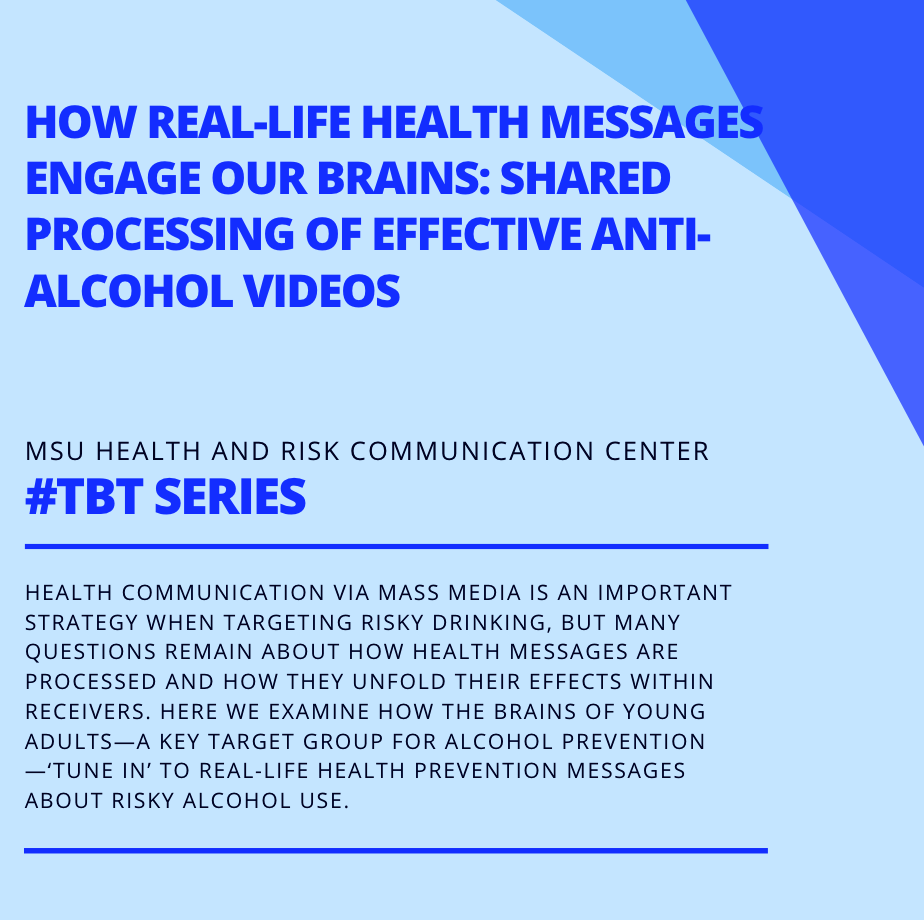
How Real-Life Health Messages Engage Our Brains: Shared Processing of Effective Anti-Alcohol Videos
March 4, 2021 - Dr. Ralf Schmälzle, Britta Renner, Harald T. Schupp, Martin A. Imhof
Health communication via mass media is an important strategy when targeting risky drinking, but many questions remain about how health messages are processed and how they unfold their effects within receivers. Here we examine how the brains of young adults—a key target group for alcohol prevention—‘tune in’ to real-life health prevention messages about risky alcohol use. In a first study, a large sample of authentic public service announcements (PSAs) targeting the risks of alcohol was characterized using established measures of message effectiveness. In the main study, we used inter-subject correlation analysis of fMRI data to examine brain responses to more and less effective PSAs in a sample of young adults. We find that more effective messages command more similar responses within widespread brain regions, including the dorsomedial prefrontal cortex, insulae and precuneus. In previous research, these regions have been related to processing narratives, emotional stimuli, self-relevance and attention towards salient stimuli. The present study thus suggests that more effective health prevention messages have greater ‘neural reach’, i.e. they engage the brains of audience members’ more widely. This work outlines a promising strategy for assessing the effects of health communication at a neural level.
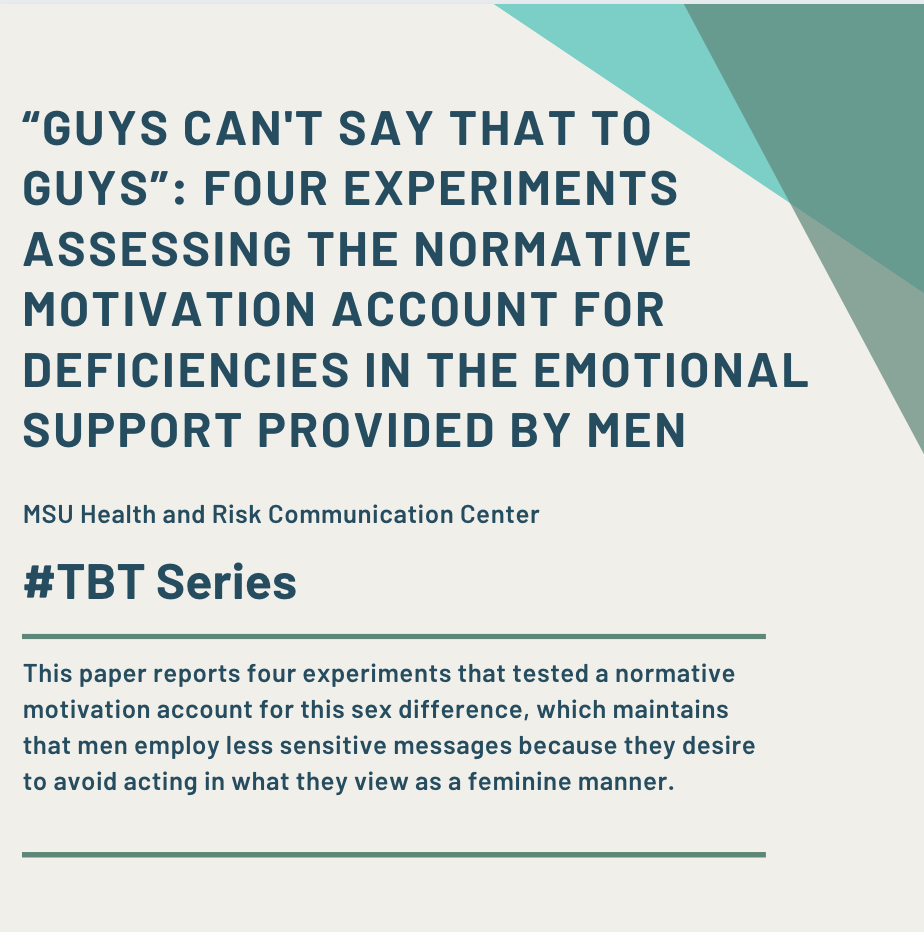
Guys Can't Say That to Guys: Four Experiments Assessing the Normative Motivation Account for Deficiencies in the Emotional Support Provided by Men
February 25, 2021 - Dr. Amanda Holstrom, Brant R. Burleson, Cristina M. Gilstrap
Men are less likely than women to provide sensitive emotional support when attempting to comfort others. This paper reports four experiments that tested a normative motivation account for this sex difference, which maintains that men employ less sensitive messages because they desire to avoid acting in what they view as a feminine manner.
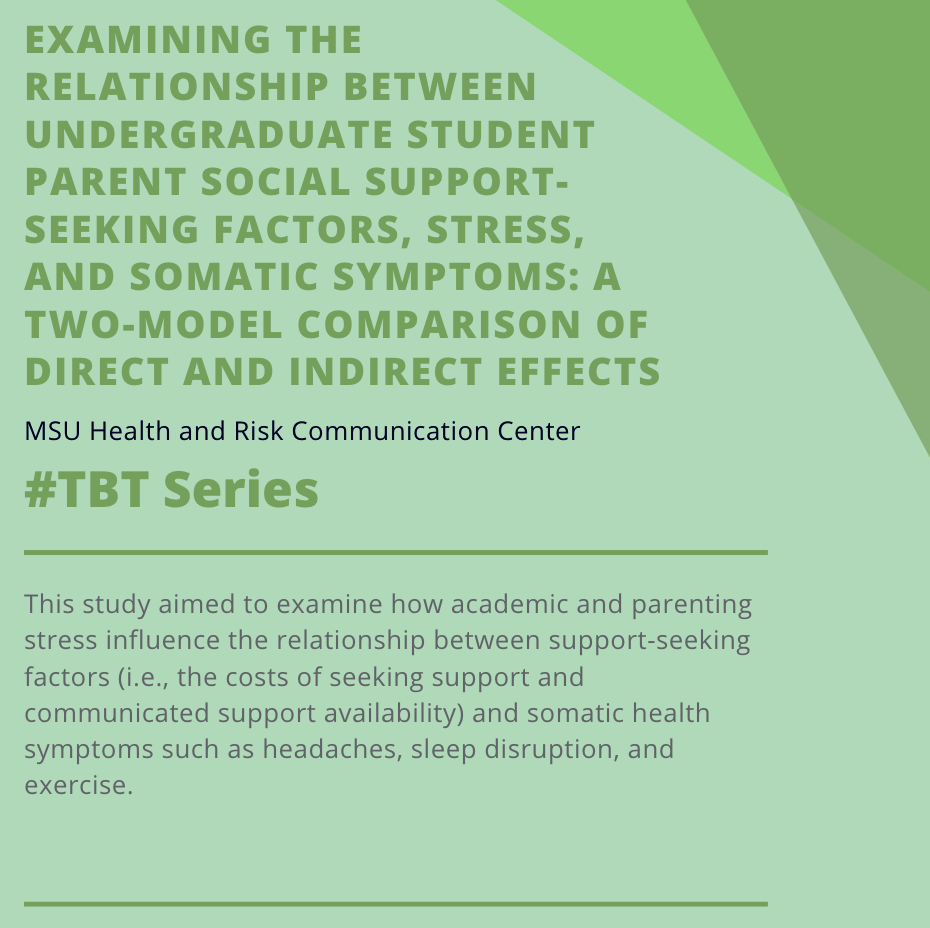
Examing the Relationship Between Undergraduate Student Parent Social Support-Seeking Factors, Stress, and Somatic Symptoms: A Two-Model Comparison of Direct and Indirect Effects
February 18, 2021 - Dr. Elizabeth Dorrance-Hall, Kristina M. Scharp
Approximately 4.8 million undergraduate students are also raising at least one child but only 26% of these student parents will graduate within six years. This study aimed to examine how academic and parenting stress influence the relationship between support-seeking factors (i.e., the costs of seeking support and communicated support availability) and somatic health symptoms such as headaches, sleep disruption, and exercise. Two parallel mediation models (n = 185 undergraduate student parents) are compared and revealed strong patterns of indirect effects. Intrapersonal and interpersonal costs indirectly influenced somatic symptoms through academic and parenting stress. Stress also mediated the relationship between support seeking factors and somatic symptoms. Theoretical implications and practical applications are discussed.
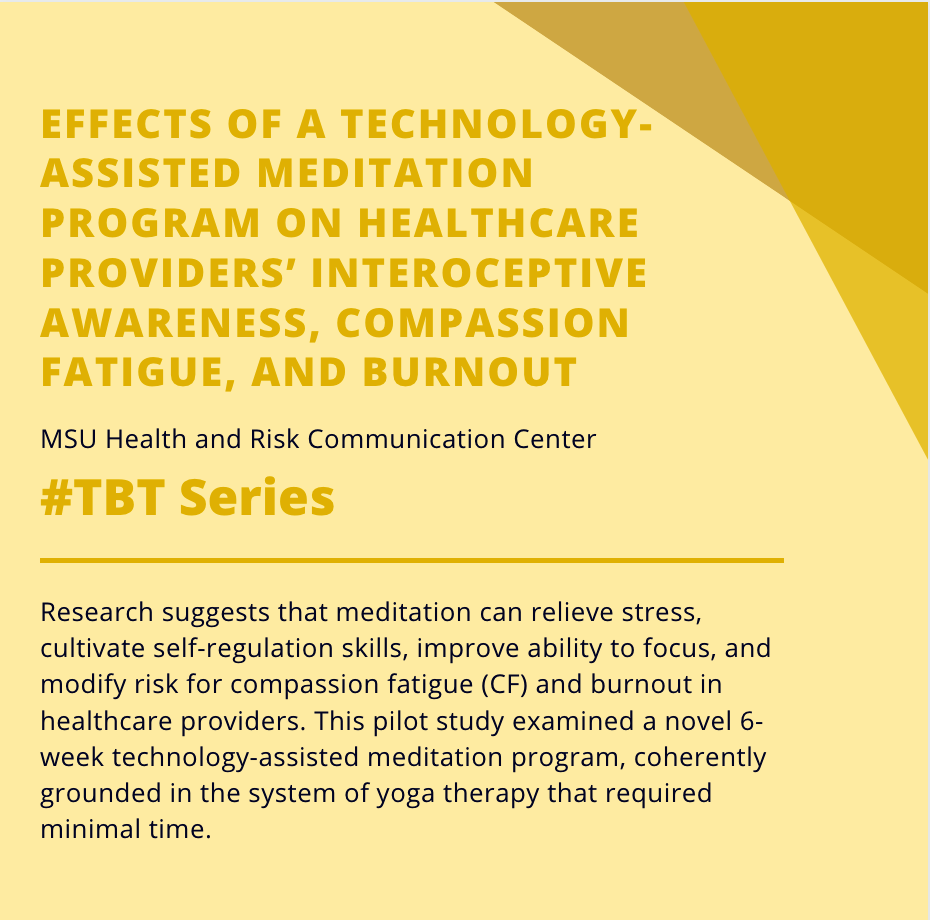
Effects of a Technology-assisted Meditation Program on Healthcare Providers' Interoceptive Awareness, Compassion Fatigue, and Burnout
February 4, 2021 - Carrie Heeter, Rebecca Lehto, Tom Day, Michelle Wiseman, Marcell Allbritton
Meditation shows promise as a method to counteract or prevent compassion fatigue (CF), burnout, and associated negative personal health issues that can emerge when healthcare providers (HCPs) are repeatedly exposed to patient suffering and related traumatic events in their work. Interoceptive awareness (heightened attention and listening to bodily sensations that arise in response to external and internal physical events and in response to emotions and thoughts) is a documented result of meditation and a possible mechanism of some of meditations’ beneficial outcomes.
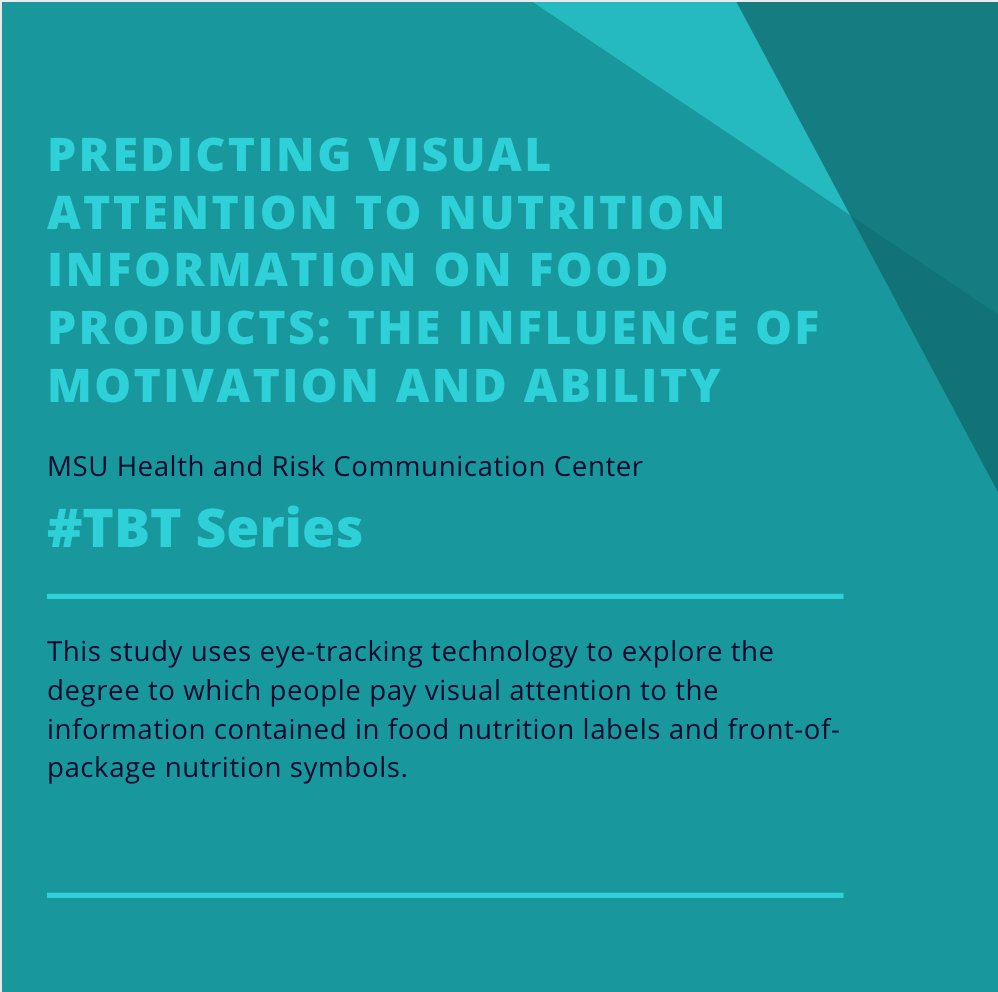
Predicting Visual Attention to Nutrition Information on Food Products: The Influence of Motivation and Ability
January 28, 2021 - Dr. Monique Turner, Christine Skubisz, Sejal Patel Pandya, Meryl Silverman, Lucinda L. Austin
This week’s #TBT comes from HRCC Faculty Feature of the month Dr. Monique Mitchell Turner, Professor and Chair of the Department of Communication at Michigan State University. This study uses eye-tracking technology to explore the degree to which people pay visual attention to the information contained in food nutrition labels and front-of-package nutrition symbols.
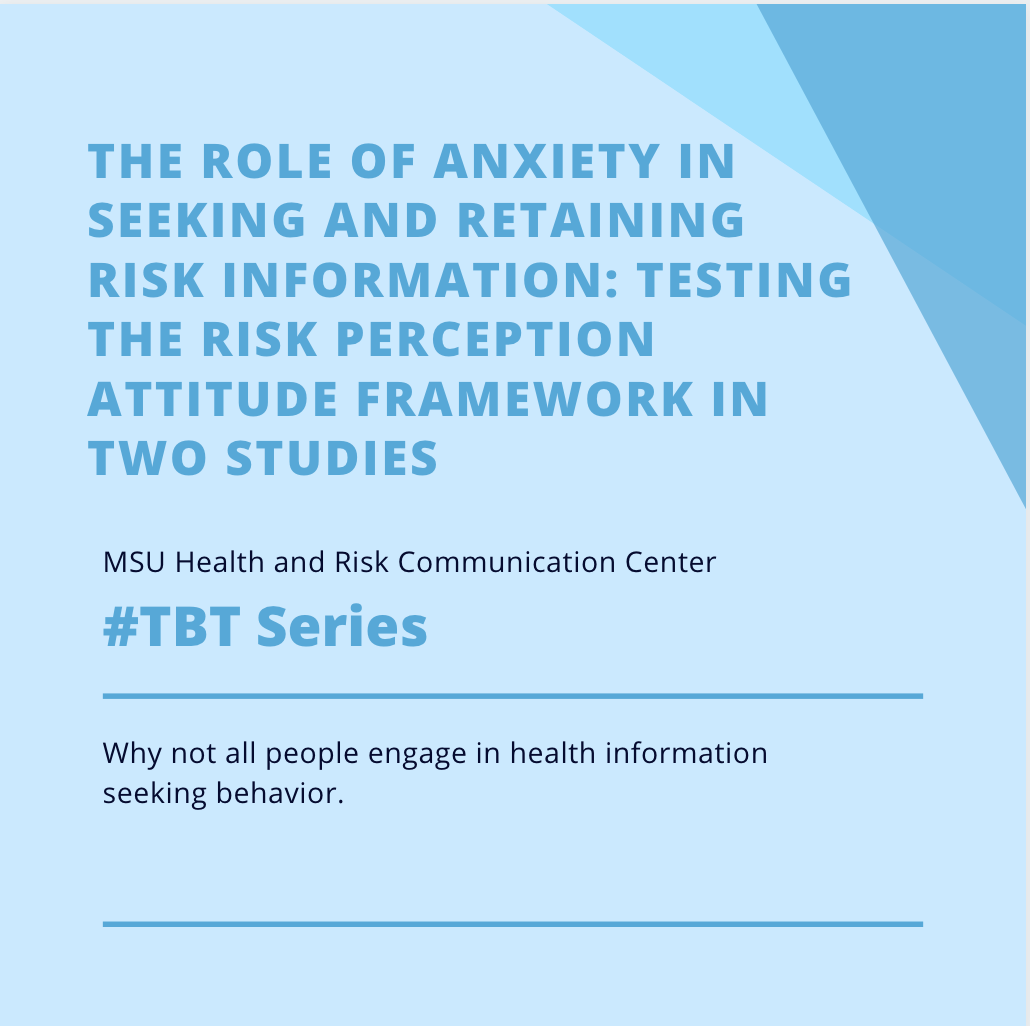
The Role of Anxiety in Seeking and Retaining Risk Information: Testing the Risk Perception Attitude Framework in Two Studies
January 14, 2021 - Dr. Monique Turner, Rajiv N. Rimal, Daniel Morrison, Hyojin Kim
This week’s #TBT comes from HRCC Faculty Feature of the month Dr. Monique Mitchell Turner, Professor and Chair of the Department of Communication at Michigan State University. The article focuses on why not all people engage in health information seeking behavior.
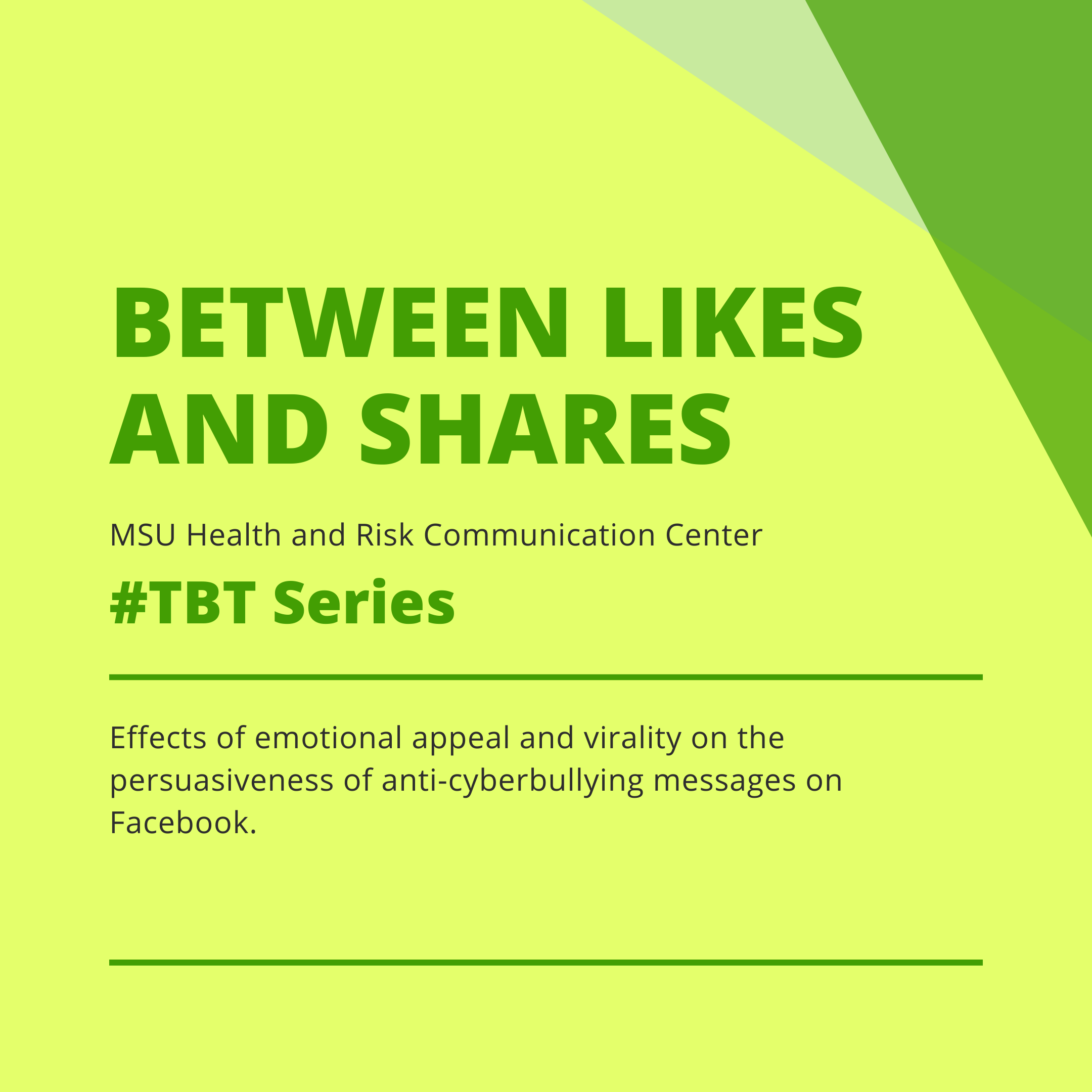
Between Likes and Shares
December 18, 2020 - Dr Saleem Alhabash, Dr. Nora Rifon, Dr. Anna McAlister, Dr. Elizabeth Quilliam, Dr. Jef Richards, Amy Hagerstrom
Last week's #TBT comes from HRCC Faculty Feature of the Month and Assistant Professor in the Department of Advertising and PR, Dr. Saleem Alhabash and Dr. Nora Rifon, HRCC affiliated faculty member and Professor in the Department of Advertising and PR and focuses on the emotional appeal and virality on the persuasiveness of anti-cyberbullying messages on Facebook.
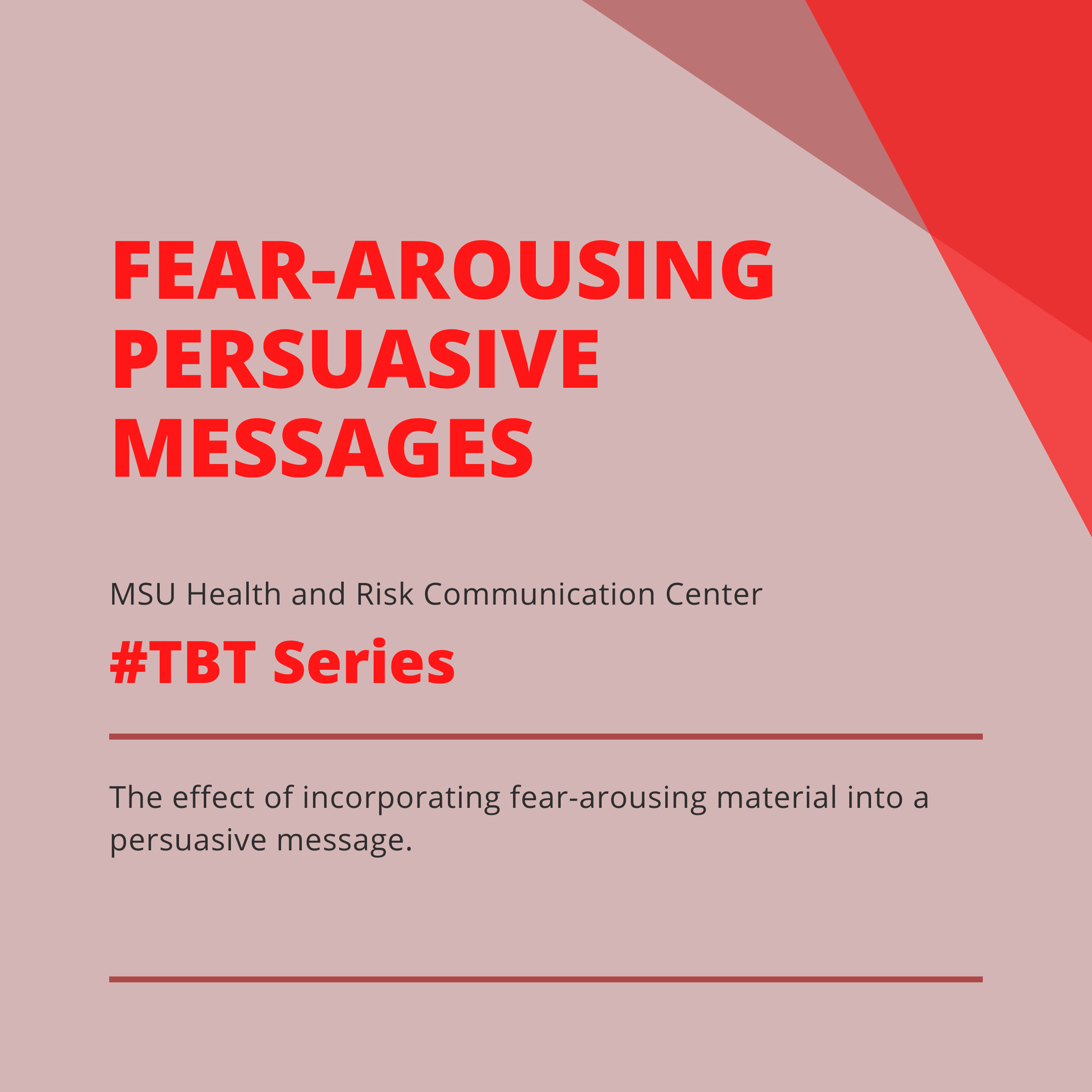
Fear-Arousing Persuasive Messages
December 3, 2020 - Franklin J. Boster and Paul Mongeau
This Throwback Thursday article is from Dr. Franklin J. Boster, former professor in the Michigan State University Department of Communication and Dr. Paul Mongeau, alum of the Michigan State University Communication PhD program. Their study focuses on the effect of incorporating fear-arousing material into a persuasive message and highlights major explanations of fear appeal effects.
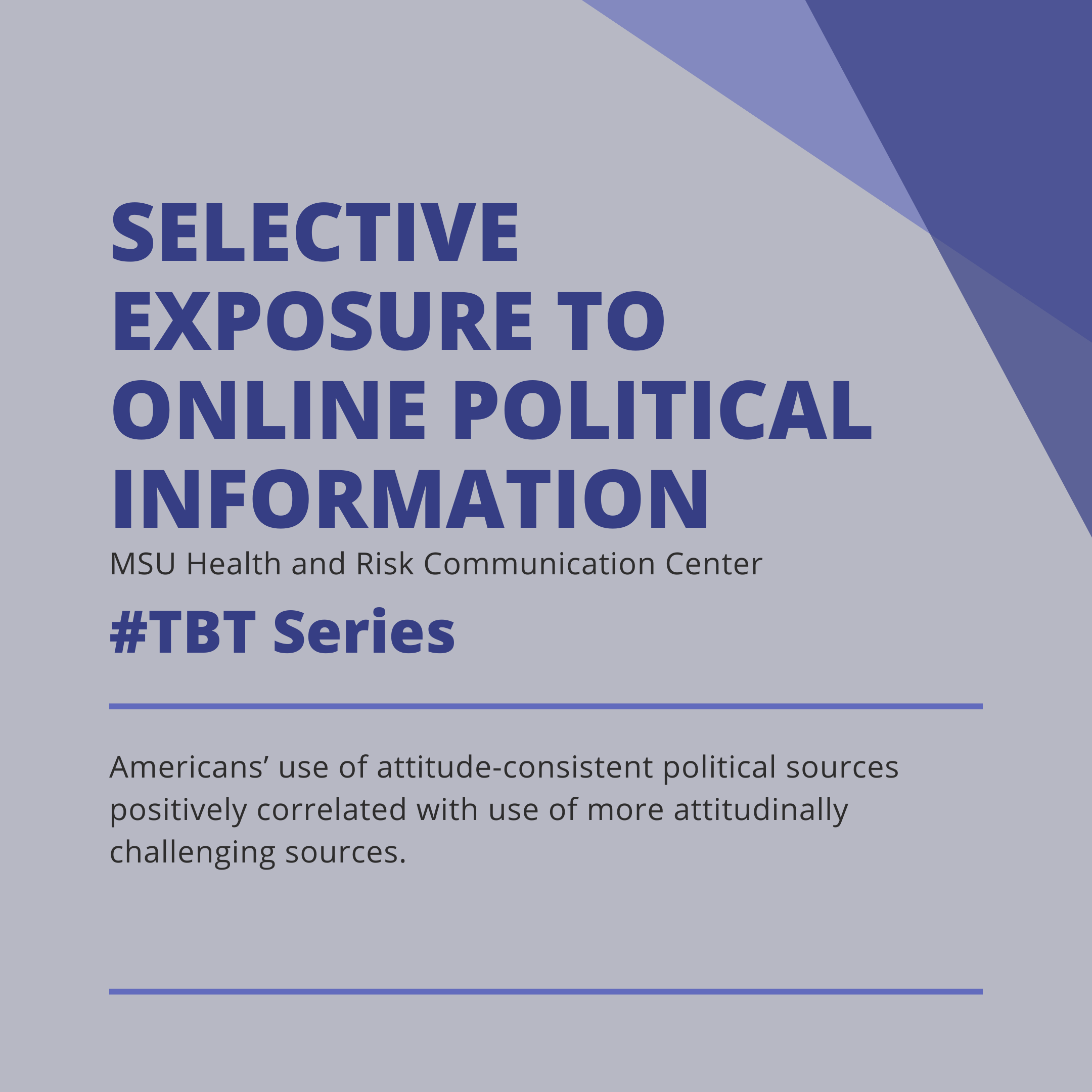
A Turn Toward Avoidance? Selective Exposure to Online Political Information
November 12, 2020 - Dustin Carnahan, R. Kelly Garrett, Emily K. Lynch
Scholars warn that avoidance of attitude-discrepant political information is becoming increasingly common due in part to an ideologically fragmented online news environment that allows individuals to systematically eschew contact with ideas that differ from their own.
How Scientists View The Public, the Media and the Political Process
November 5, 2020 - John Besley, Matthew Nisbet
The first issue of Public Understanding of Science in 1992 included a suggestion that science com-munication scholars “supplement our studies and activities on the understanding of science by the public, with studies and activities on the understanding of the public by scientists” (Levy-Leblond, 1992: 20). In the last decade, a number of scholars have taken up this call using in-depth interviews, case studies and surveys with small samples to highlight common elements of scientists’ views about the public. Bauer, Allum and Miller (2007) argue that this phase of research largely began in the mid-1990s as a critique of “scientific institutions and experts who harbor prejudices about an ignorant public” (p. 85).

Overall Assessment of the Speaker’s Experience of Stuttering (OASES): Documenting multiple outcomes in stuttering treatment
October 28, 2020 - Dr. J. Scott Yaruss, Robert W. Quesal
In recent years, there has been a growing discussion about the importance of evidence-based practice (EBP) in the field of speech–language pathology. Although the changes associated with implementing EBP affect many aspects of the field, the need for clinicians to document the results of their intervention and to select treatment approaches based on a meaningful body of literature has been particularly apparent in the field of fluency disorders.
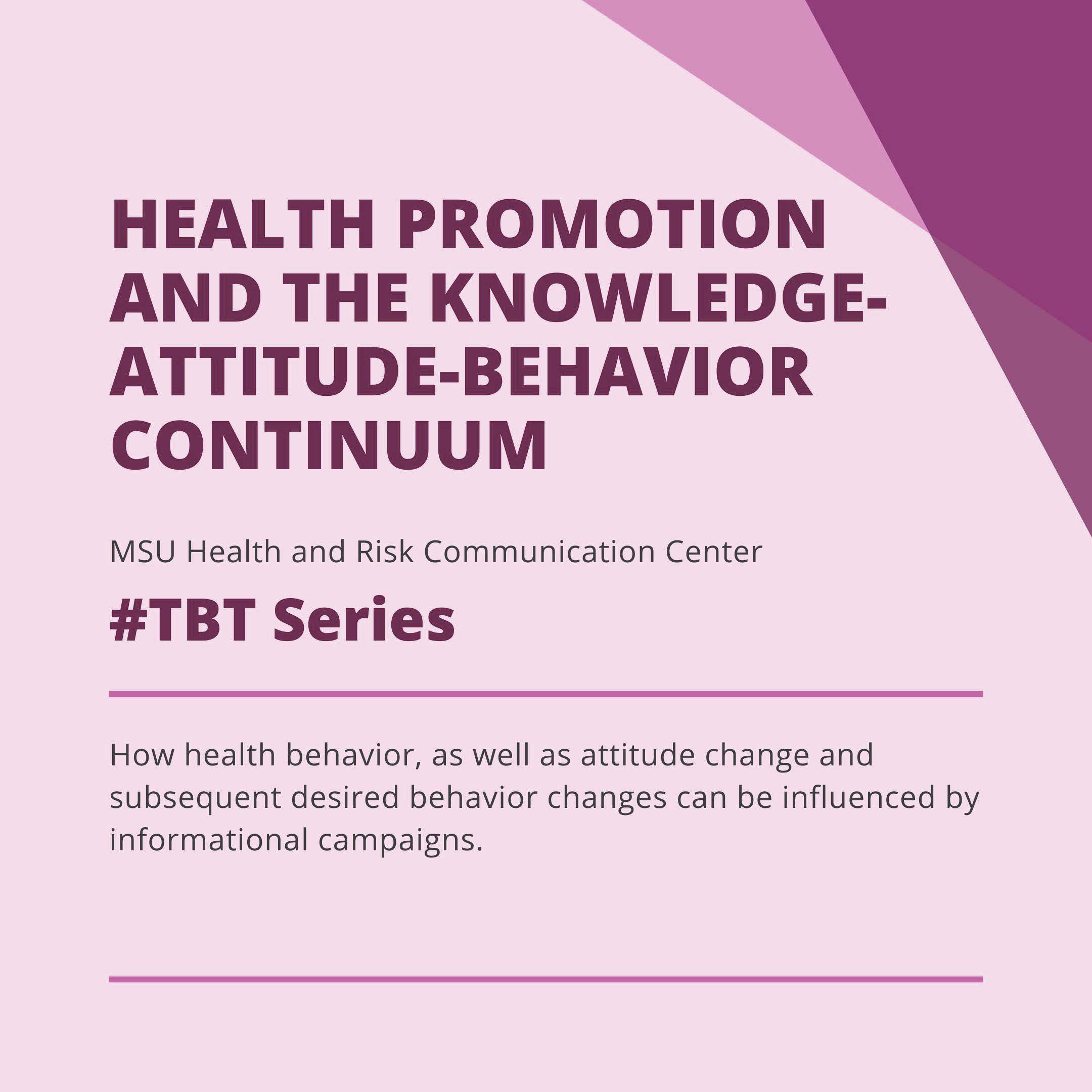
Health Promotion and the Knowledge-Attitude-Behavior Continuum
October 14, 2020 - Erv Bettinghaus
Influencing health behavior through informational campaigns, followed by the expectation of attitude change and subsequent desired behavior changes, is examined is this article by Erv Bettinghaus.
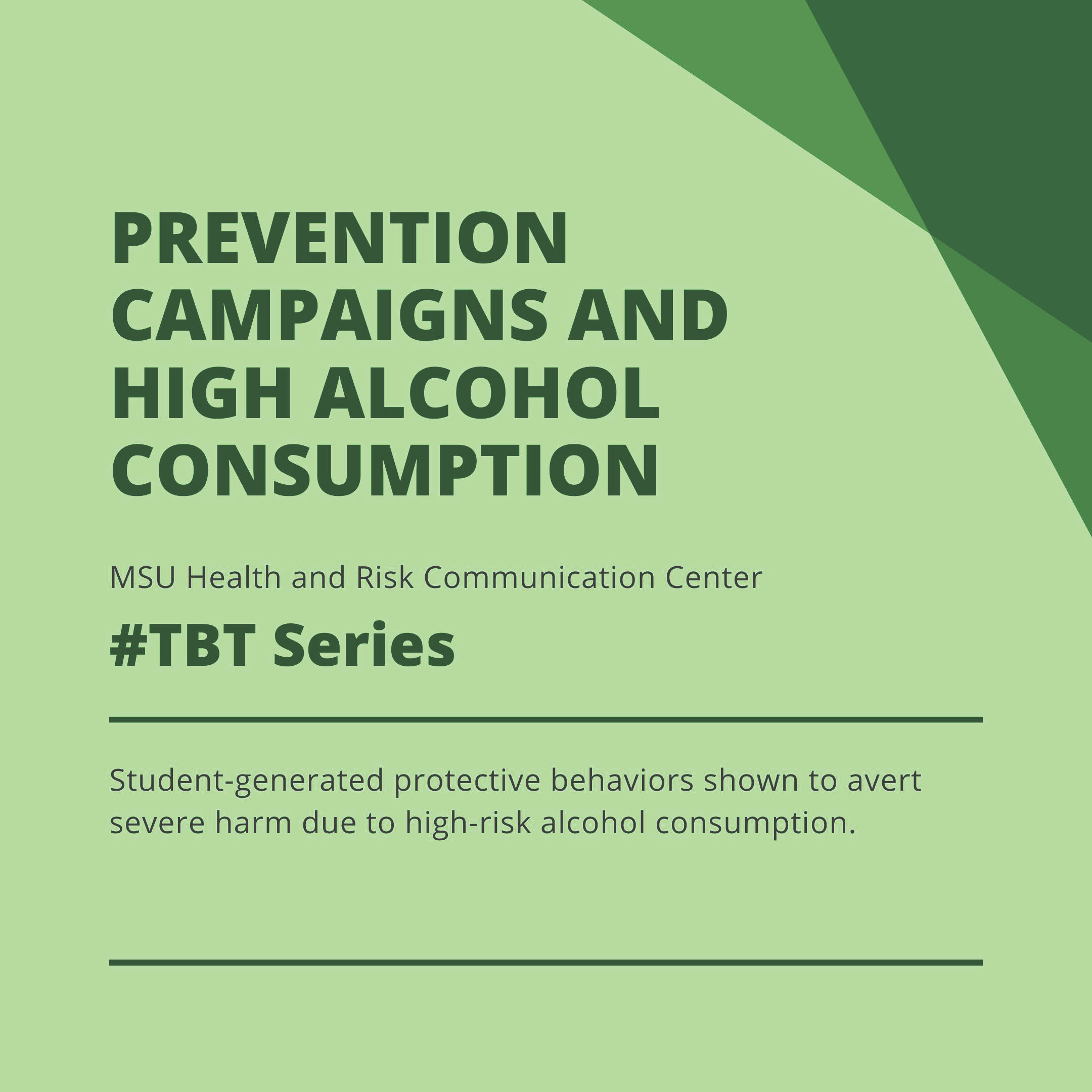
Student-Generated Protective Behaviors to Avert Severe Harm Due to High-Risk Alcohol Consumption
September 23, 2020 - Sandi Smith, Charles Atkin, Carolyn LaPlante, Katherine Klein, Wilma Novales Wibert, Edward Glazer, Alex Mayer, Dennis Martell
High-risk alcohol consumption is a significant problem on college campuses that many students see as a rite of passage in their development into adulthood. Developing effective prevention campaigns designed to lessen or avert the risks associated with alcohol consumption entails understanding how students perceive harmful consequences as well as the ways they protect themselves while drinking.
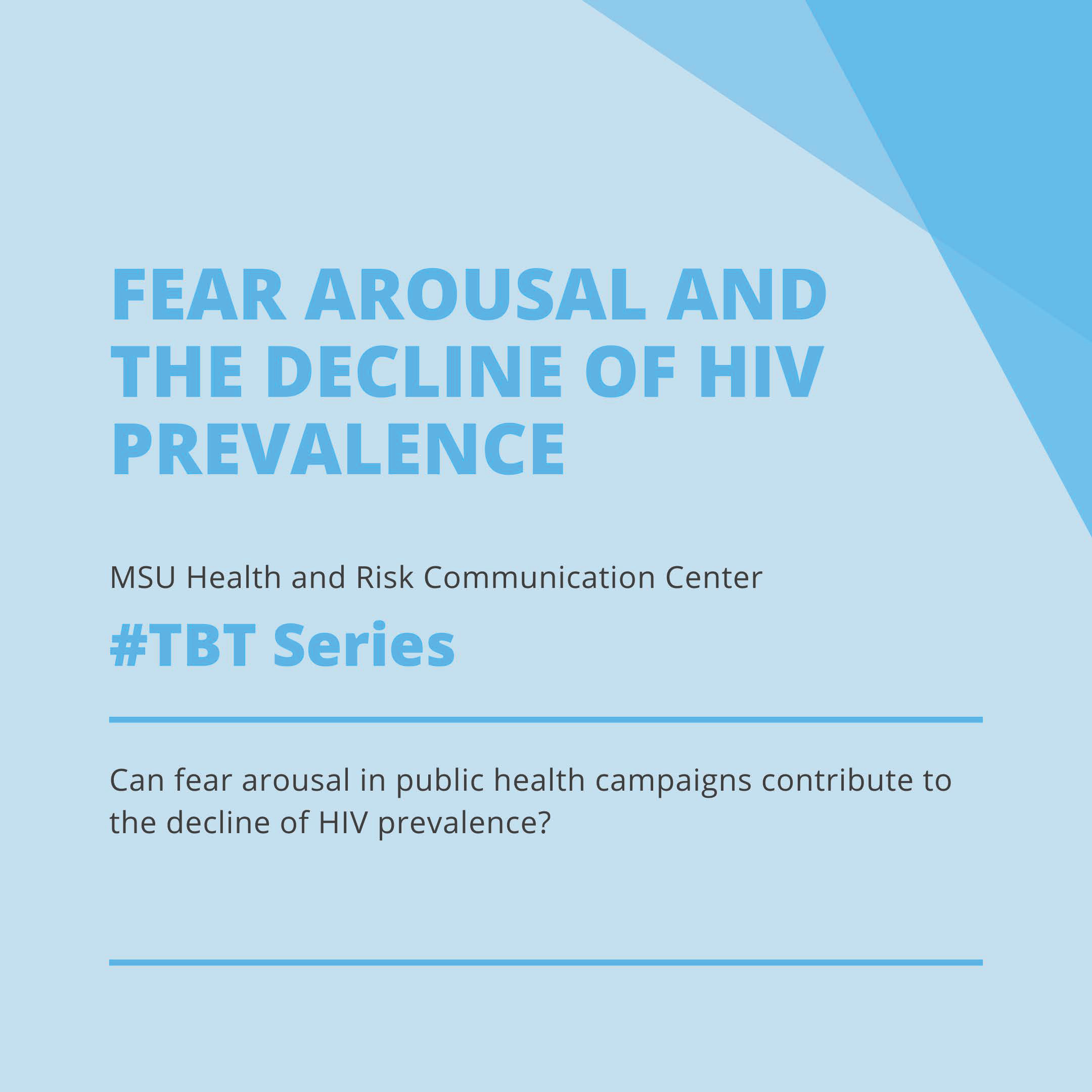
Can Fear Arousal in Public Health Campaigns Contribute to the Decline of HIV Prevalence?
September 16, 2020 - Kim Witte and Edward C. Green
‘‘Fear appeal’’ campaigns, as they typically are called by academics, have been derided by American AIDS professionals as ‘‘amateurish,’’ ‘‘misguided,’’ and even unethical because they are seen as limiting one’s ability to consider dispassionately a range of responses to a perceived health threat. Yet, many African professionals have embraced fear-based campaigns and claim they are at least one of the reasons HIV infection rates dropped significantly in certain areas.
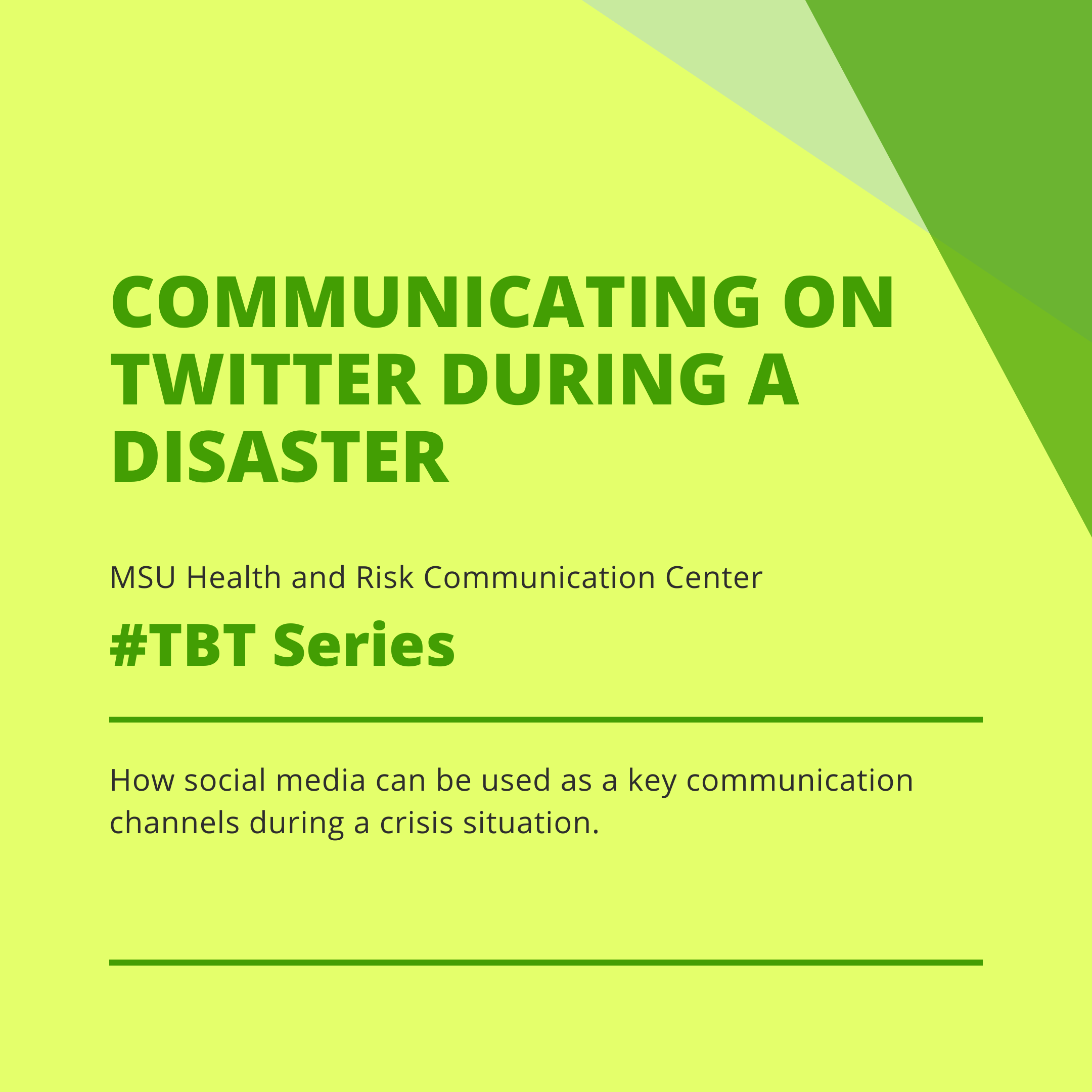
Communicating on Twitter during a disaster: An analysis of tweets during Typhoon Haiyan in the Philippines
September 8, 2020 - Bruno Takahashi, Edson C. Tandoc Jr., Christine Carmichael
September is National Preparedness Month which promotes family and community disaster planning now and throughout the year. Social media in crisis situations, such as natural disasters, has been recognized by scholars and practitioners as key communication channels that can complement traditional channels. This study from Bruno Takahashi, Edson C. Tandoc Jr. and Christine Carmichael examines Twitter use during and after Typhoon Haiyan pummeled the Philippines.
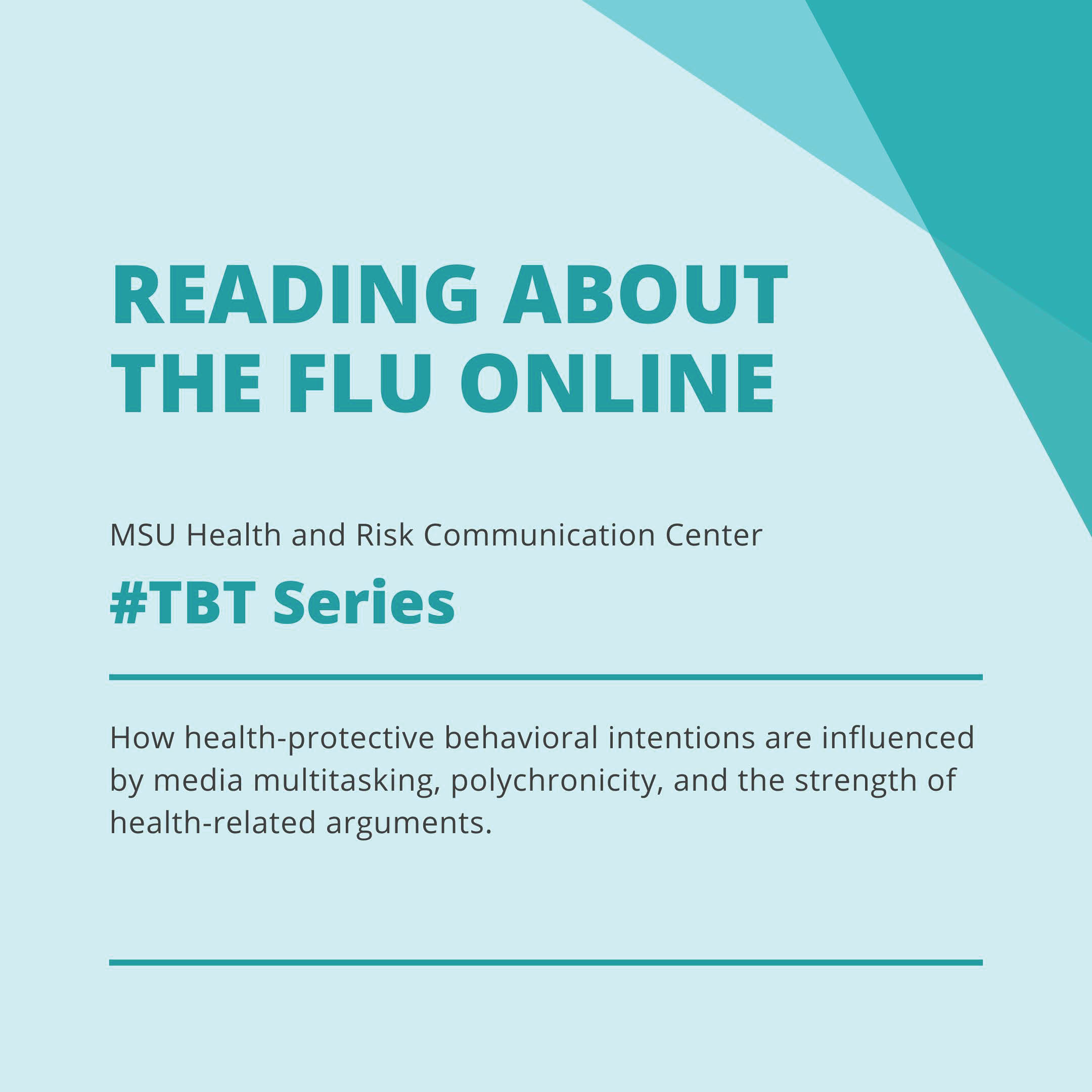
Reading About the Flu Online: How Health-Protective Behavioral Intentions Are Influenced byMedia Multitasking, Polychronicity, and Strength of Health-Related Arguments
August 25, 2020 - Anastasia Kononova, Shupei Yuan and Eunsin Joo
As health organizations increasingly use the Internet to communicate medical information and advice (Shortliffe et al., 2000; World Health Organization, 2013), studying factors that affect health information processing and health-protective behaviors becomes extremely important.

